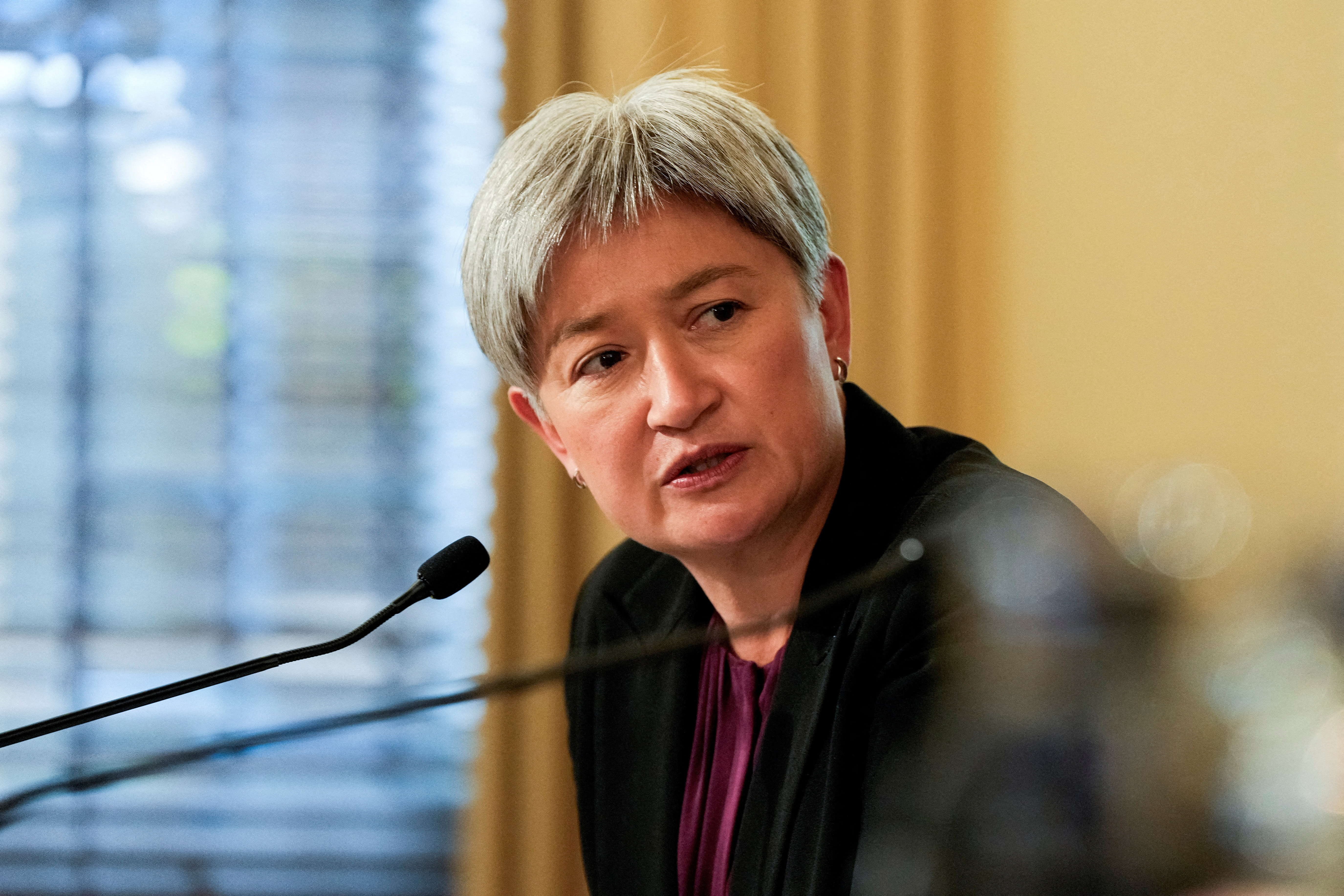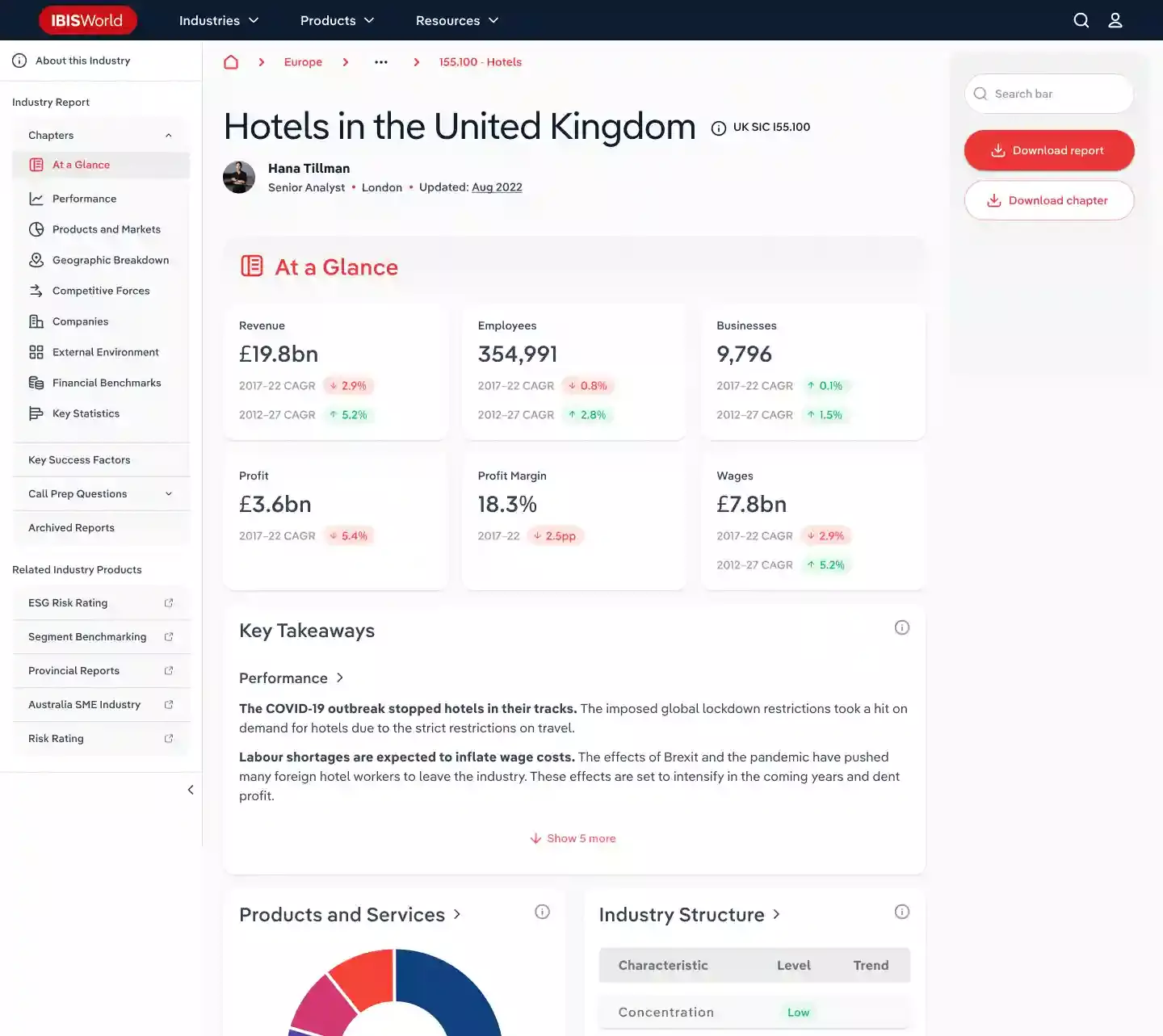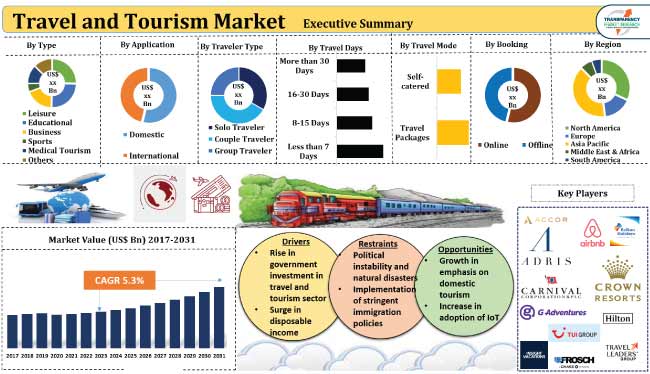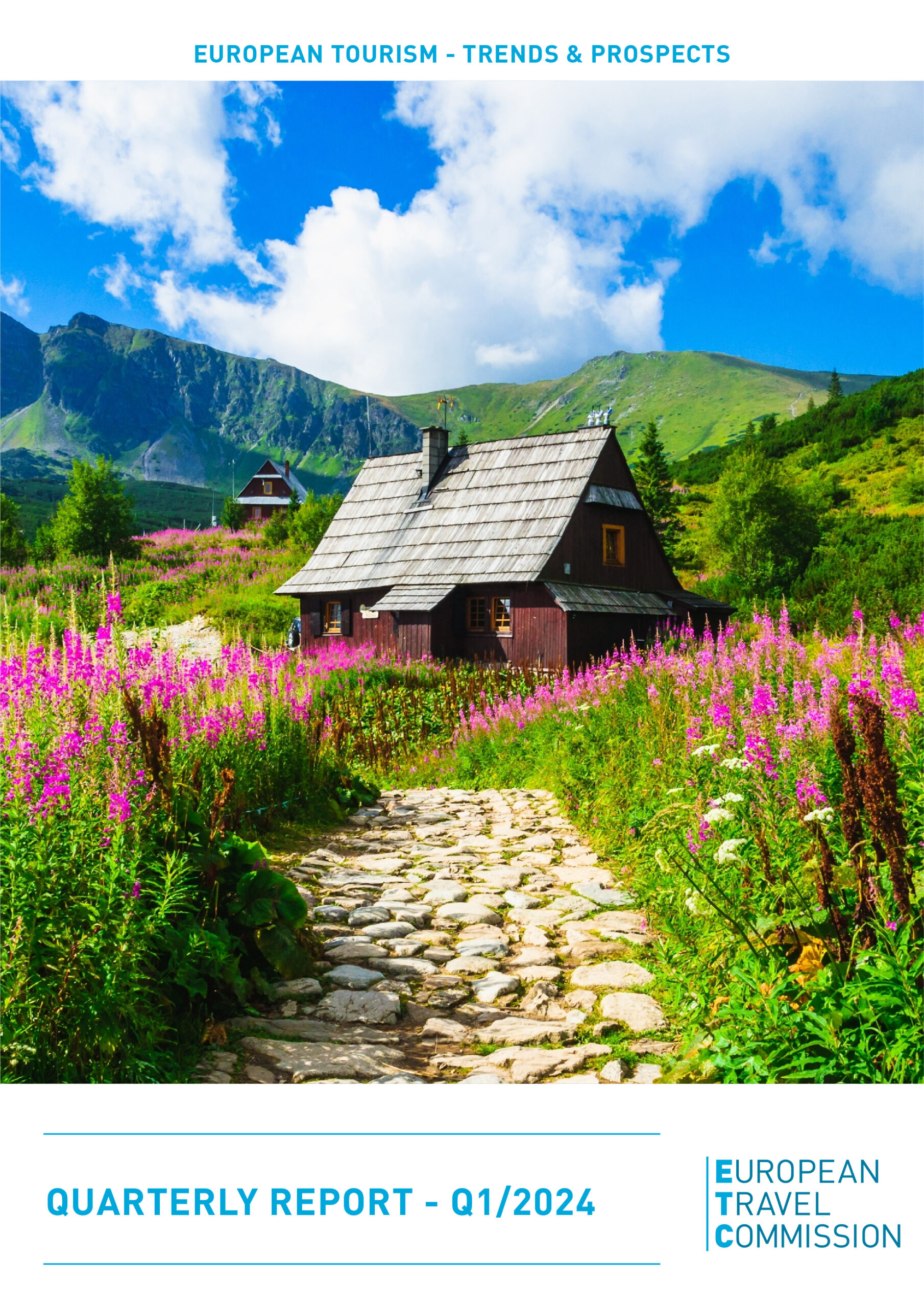The future of tourism: Bridging the labor gap, enhancing customer experience
As travel resumes and builds momentum, it’s becoming clear that tourism is resilient—there is an enduring desire to travel. Against all odds, international tourism rebounded in 2022: visitor numbers to Europe and the Middle East climbed to around 80 percent of 2019 levels, and the Americas recovered about 65 percent of prepandemic visitors 1 “Tourism set to return to pre-pandemic levels in some regions in 2023,” United Nations World Tourism Organization (UNWTO), January 17, 2023. —a number made more significant because it was reached without travelers from China, which had the world’s largest outbound travel market before the pandemic. 2 “ Outlook for China tourism 2023: Light at the end of the tunnel ,” McKinsey, May 9, 2023.
Recovery and growth are likely to continue. According to estimates from the World Tourism Organization (UNWTO) for 2023, international tourist arrivals could reach 80 to 95 percent of prepandemic levels depending on the extent of the economic slowdown, travel recovery in Asia–Pacific, and geopolitical tensions, among other factors. 3 “Tourism set to return to pre-pandemic levels in some regions in 2023,” United Nations World Tourism Organization (UNWTO), January 17, 2023. Similarly, the World Travel & Tourism Council (WTTC) forecasts that by the end of 2023, nearly half of the 185 countries in which the organization conducts research will have either recovered to prepandemic levels or be within 95 percent of full recovery. 4 “Global travel and tourism catapults into 2023 says WTTC,” World Travel & Tourism Council (WTTC), April 26, 2023.
Longer-term forecasts also point to optimism for the decade ahead. Travel and tourism GDP is predicted to grow, on average, at 5.8 percent a year between 2022 and 2032, outpacing the growth of the overall economy at an expected 2.7 percent a year. 5 Travel & Tourism economic impact 2022 , WTTC, August 2022.
So, is it all systems go for travel and tourism? Not really. The industry continues to face a prolonged and widespread labor shortage. After losing 62 million travel and tourism jobs in 2020, labor supply and demand remain out of balance. 6 “WTTC research reveals Travel & Tourism’s slow recovery is hitting jobs and growth worldwide,” World Travel & Tourism Council, October 6, 2021. Today, in the European Union, 11 percent of tourism jobs are likely to go unfilled; in the United States, that figure is 7 percent. 7 Travel & Tourism economic impact 2022 : Staff shortages, WTTC, August 2022.
There has been an exodus of tourism staff, particularly from customer-facing roles, to other sectors, and there is no sign that the industry will be able to bring all these people back. 8 Travel & Tourism economic impact 2022 : Staff shortages, WTTC, August 2022. Hotels, restaurants, cruises, airports, and airlines face staff shortages that can translate into operational, reputational, and financial difficulties. If unaddressed, these shortages may constrain the industry’s growth trajectory.
The current labor shortage may have its roots in factors related to the nature of work in the industry. Chronic workplace challenges, coupled with the effects of COVID-19, have culminated in an industry struggling to rebuild its workforce. Generally, tourism-related jobs are largely informal, partly due to high seasonality and weak regulation. And conditions such as excessively long working hours, low wages, a high turnover rate, and a lack of social protection tend to be most pronounced in an informal economy. Additionally, shift work, night work, and temporary or part-time employment are common in tourism.
The industry may need to revisit some fundamentals to build a far more sustainable future: either make the industry more attractive to talent (and put conditions in place to retain staff for longer periods) or improve products, services, and processes so that they complement existing staffing needs or solve existing pain points.
One solution could be to build a workforce with the mix of digital and interpersonal skills needed to keep up with travelers’ fast-changing requirements. The industry could make the most of available technology to provide customers with a digitally enhanced experience, resolve staff shortages, and improve working conditions.

Would you like to learn more about our Travel, Logistics & Infrastructure Practice ?
Complementing concierges with chatbots.
The pace of technological change has redefined customer expectations. Technology-driven services are often at customers’ fingertips, with no queues or waiting times. By contrast, the airport and airline disruption widely reported in the press over the summer of 2022 points to customers not receiving this same level of digital innovation when traveling.
Imagine the following travel experience: it’s 2035 and you start your long-awaited honeymoon to a tropical island. A virtual tour operator and a destination travel specialist booked your trip for you; you connected via videoconference to make your plans. Your itinerary was chosen with the support of generative AI , which analyzed your preferences, recommended personalized travel packages, and made real-time adjustments based on your feedback.
Before leaving home, you check in online and QR code your luggage. You travel to the airport by self-driving cab. After dropping off your luggage at the self-service counter, you pass through security and the biometric check. You access the premier lounge with the QR code on the airline’s loyalty card and help yourself to a glass of wine and a sandwich. After your flight, a prebooked, self-driving cab takes you to the resort. No need to check in—that was completed online ahead of time (including picking your room and making sure that the hotel’s virtual concierge arranged for red roses and a bottle of champagne to be delivered).
While your luggage is brought to the room by a baggage robot, your personal digital concierge presents the honeymoon itinerary with all the requested bookings. For the romantic dinner on the first night, you order your food via the restaurant app on the table and settle the bill likewise. So far, you’ve had very little human interaction. But at dinner, the sommelier chats with you in person about the wine. The next day, your sightseeing is made easier by the hotel app and digital guide—and you don’t get lost! With the aid of holographic technology, the virtual tour guide brings historical figures to life and takes your sightseeing experience to a whole new level. Then, as arranged, a local citizen meets you and takes you to their home to enjoy a local family dinner. The trip is seamless, there are no holdups or snags.
This scenario features less human interaction than a traditional trip—but it flows smoothly due to the underlying technology. The human interactions that do take place are authentic, meaningful, and add a special touch to the experience. This may be a far-fetched example, but the essence of the scenario is clear: use technology to ease typical travel pain points such as queues, misunderstandings, or misinformation, and elevate the quality of human interaction.
Travel with less human interaction may be considered a disruptive idea, as many travelers rely on and enjoy the human connection, the “service with a smile.” This will always be the case, but perhaps the time is right to think about bringing a digital experience into the mix. The industry may not need to depend exclusively on human beings to serve its customers. Perhaps the future of travel is physical, but digitally enhanced (and with a smile!).
Digital solutions are on the rise and can help bridge the labor gap
Digital innovation is improving customer experience across multiple industries. Car-sharing apps have overcome service-counter waiting times and endless paperwork that travelers traditionally had to cope with when renting a car. The same applies to time-consuming hotel check-in, check-out, and payment processes that can annoy weary customers. These pain points can be removed. For instance, in China, the Huazhu Hotels Group installed self-check-in kiosks that enable guests to check in or out in under 30 seconds. 9 “Huazhu Group targets lifestyle market opportunities,” ChinaTravelNews, May 27, 2021.
Technology meets hospitality
In 2019, Alibaba opened its FlyZoo Hotel in Huangzhou, described as a “290-room ultra-modern boutique, where technology meets hospitality.” 1 “Chinese e-commerce giant Alibaba has a hotel run almost entirely by robots that can serve food and fetch toiletries—take a look inside,” Business Insider, October 21, 2019; “FlyZoo Hotel: The hotel of the future or just more technology hype?,” Hotel Technology News, March 2019. The hotel was the first of its kind that instead of relying on traditional check-in and key card processes, allowed guests to manage reservations and make payments entirely from a mobile app, to check-in using self-service kiosks, and enter their rooms using facial-recognition technology.
The hotel is run almost entirely by robots that serve food and fetch toiletries and other sundries as needed. Each guest room has a voice-activated smart assistant to help guests with a variety of tasks, from adjusting the temperature, lights, curtains, and the TV to playing music and answering simple questions about the hotel and surroundings.
The hotel was developed by the company’s online travel platform, Fliggy, in tandem with Alibaba’s AI Labs and Alibaba Cloud technology with the goal of “leveraging cutting-edge tech to help transform the hospitality industry, one that keeps the sector current with the digital era we’re living in,” according to the company.
Adoption of some digitally enhanced services was accelerated during the pandemic in the quest for safer, contactless solutions. During the Winter Olympics in Beijing, a restaurant designed to keep physical contact to a minimum used a track system on the ceiling to deliver meals directly from the kitchen to the table. 10 “This Beijing Winter Games restaurant uses ceiling-based tracks,” Trendhunter, January 26, 2022. Customers around the world have become familiar with restaurants using apps to display menus, take orders, and accept payment, as well as hotels using robots to deliver luggage and room service (see sidebar “Technology meets hospitality”). Similarly, theme parks, cinemas, stadiums, and concert halls are deploying digital solutions such as facial recognition to optimize entrance control. Shanghai Disneyland, for example, offers annual pass holders the option to choose facial recognition to facilitate park entry. 11 “Facial recognition park entry,” Shanghai Disney Resort website.
Automation and digitization can also free up staff from attending to repetitive functions that could be handled more efficiently via an app and instead reserve the human touch for roles where staff can add the most value. For instance, technology can help customer-facing staff to provide a more personalized service. By accessing data analytics, frontline staff can have guests’ details and preferences at their fingertips. A trainee can become an experienced concierge in a short time, with the help of technology.
Apps and in-room tech: Unused market potential
According to Skift Research calculations, total revenue generated by guest apps and in-room technology in 2019 was approximately $293 million, including proprietary apps by hotel brands as well as third-party vendors. 1 “Hotel tech benchmark: Guest-facing technology 2022,” Skift Research, November 2022. The relatively low market penetration rate of this kind of tech points to around $2.4 billion in untapped revenue potential (exhibit).
Even though guest-facing technology is available—the kind that can facilitate contactless interactions and offer travelers convenience and personalized service—the industry is only beginning to explore its potential. A report by Skift Research shows that the hotel industry, in particular, has not tapped into tech’s potential. Only 11 percent of hotels and 25 percent of hotel rooms worldwide are supported by a hotel app or use in-room technology, and only 3 percent of hotels offer keyless entry. 12 “Hotel tech benchmark: Guest-facing technology 2022,” Skift Research, November 2022. Of the five types of technology examined (guest apps and in-room tech; virtual concierge; guest messaging and chatbots; digital check-in and kiosks; and keyless entry), all have relatively low market-penetration rates (see sidebar “Apps and in-room tech: Unused market potential”).
While apps, digitization, and new technology may be the answer to offering better customer experience, there is also the possibility that tourism may face competition from technological advances, particularly virtual experiences. Museums, attractions, and historical sites can be made interactive and, in some cases, more lifelike, through AR/VR technology that can enhance the physical travel experience by reconstructing historical places or events.
Up until now, tourism, arguably, was one of a few sectors that could not easily be replaced by tech. It was not possible to replicate the physical experience of traveling to another place. With the emerging metaverse , this might change. Travelers could potentially enjoy an event or experience from their sofa without any logistical snags, and without the commitment to traveling to another country for any length of time. For example, Google offers virtual tours of the Pyramids of Meroë in Sudan via an immersive online experience available in a range of languages. 13 Mariam Khaled Dabboussi, “Step into the Meroë pyramids with Google,” Google, May 17, 2022. And a crypto banking group, The BCB Group, has created a metaverse city that includes representations of some of the most visited destinations in the world, such as the Great Wall of China and the Statue of Liberty. According to BCB, the total cost of flights, transfers, and entry for all these landmarks would come to $7,600—while a virtual trip would cost just over $2. 14 “What impact can the Metaverse have on the travel industry?,” Middle East Economy, July 29, 2022.
The metaverse holds potential for business travel, too—the meeting, incentives, conferences, and exhibitions (MICE) sector in particular. Participants could take part in activities in the same immersive space while connecting from anywhere, dramatically reducing travel, venue, catering, and other costs. 15 “ Tourism in the metaverse: Can travel go virtual? ,” McKinsey, May 4, 2023.
The allure and convenience of such digital experiences make offering seamless, customer-centric travel and tourism in the real world all the more pressing.

Three innovations to solve hotel staffing shortages
Is the future contactless.
Given the advances in technology, and the many digital innovations and applications that already exist, there is potential for businesses across the travel and tourism spectrum to cope with labor shortages while improving customer experience. Process automation and digitization can also add to process efficiency. Taken together, a combination of outsourcing, remote work, and digital solutions can help to retain existing staff and reduce dependency on roles that employers are struggling to fill (exhibit).
Depending on the customer service approach and direct contact need, we estimate that the travel and tourism industry would be able to cope with a structural labor shortage of around 10 to 15 percent in the long run by operating more flexibly and increasing digital and automated efficiency—while offering the remaining staff an improved total work package.
Outsourcing and remote work could also help resolve the labor shortage
While COVID-19 pushed organizations in a wide variety of sectors to embrace remote work, there are many hospitality roles that rely on direct physical services that cannot be performed remotely, such as laundry, cleaning, maintenance, and facility management. If faced with staff shortages, these roles could be outsourced to third-party professional service providers, and existing staff could be reskilled to take up new positions.
In McKinsey’s experience, the total service cost of this type of work in a typical hotel can make up 10 percent of total operating costs. Most often, these roles are not guest facing. A professional and digital-based solution might become an integrated part of a third-party service for hotels looking to outsource this type of work.
One of the lessons learned in the aftermath of COVID-19 is that many tourism employees moved to similar positions in other sectors because they were disillusioned by working conditions in the industry . Specialist multisector companies have been able to shuffle their staff away from tourism to other sectors that offer steady employment or more regular working hours compared with the long hours and seasonal nature of work in tourism.
The remaining travel and tourism staff may be looking for more flexibility or the option to work from home. This can be an effective solution for retaining employees. For example, a travel agent with specific destination expertise could work from home or be consulted on an needs basis.
In instances where remote work or outsourcing is not viable, there are other solutions that the hospitality industry can explore to improve operational effectiveness as well as employee satisfaction. A more agile staffing model can better match available labor with peaks and troughs in daily, or even hourly, demand. This could involve combining similar roles or cross-training staff so that they can switch roles. Redesigned roles could potentially improve employee satisfaction by empowering staff to explore new career paths within the hotel’s operations. Combined roles build skills across disciplines—for example, supporting a housekeeper to train and become proficient in other maintenance areas, or a front-desk associate to build managerial skills.
Where management or ownership is shared across properties, roles could be staffed to cover a network of sites, rather than individual hotels. By applying a combination of these approaches, hotels could reduce the number of staff hours needed to keep operations running at the same standard. 16 “ Three innovations to solve hotel staffing shortages ,” McKinsey, April 3, 2023.
Taken together, operational adjustments combined with greater use of technology could provide the tourism industry with a way of overcoming staffing challenges and giving customers the seamless digitally enhanced experiences they expect in other aspects of daily life.
In an industry facing a labor shortage, there are opportunities for tech innovations that can help travel and tourism businesses do more with less, while ensuring that remaining staff are engaged and motivated to stay in the industry. For travelers, this could mean fewer friendly faces, but more meaningful experiences and interactions.
Urs Binggeli is a senior expert in McKinsey’s Zurich office, Zi Chen is a capabilities and insights specialist in the Shanghai office, Steffen Köpke is a capabilities and insights expert in the Düsseldorf office, and Jackey Yu is a partner in the Hong Kong office.
Explore a career with us
Travel, Tourism & Hospitality
Industry-specific and extensively researched technical data (partially from exclusive partnerships). A paid subscription is required for full access.
Inbound and outbound visitor growth worldwide 2020-2025
According to a 2024 study, the number of both inbound arrivals and outbound visits globally is expected to grow that year. After the dramatic decline with the onset of the coronavirus (COVID-19) pandemic, and the rebound in 2022, inbound overnight arrivals and outbound trips worldwide are forecast to increase by 17.4 percent and 17 percent, respectively, in 2024 compared to the previous year.
Inbound and outbound visitor growth worldwide from 2020 to 2022, with a forecast until 2025
- Immediate access to 1m+ statistics
- Incl. source references
- Download as PNG, PDF, XLS, PPT
Additional Information
Show sources information Show publisher information Use Ask Statista Research Service
February 2024
2020 to 2022
Data for 2020 were previously published by the source. Figures for 2022 are estimates. Data from 2023 to 2025 are forecasts. Inbound refers to the sum of the overnight tourist arrivals and includes intra-regional flows. Outbound refers to the sum of visits to all destinations. Figures were calculated using the Global Travel Service (GTS) model as of December 12, 2023.
Other statistics on the topic
Number of inbound visitors to Japan 2005-2023
Number of overseas tourists in Tokyo 2013-2022
Number of inbound visitors in Japan 2023, by region
Monthly number of foreign visitors to Japan 2019-2023
To download this statistic in XLS format you need a Statista Account
To download this statistic in PNG format you need a Statista Account
To download this statistic in PDF format you need a Statista Account
To download this statistic in PPT format you need a Statista Account
As a Premium user you get access to the detailed source references and background information about this statistic.
As a Premium user you get access to background information and details about the release of this statistic.
As soon as this statistic is updated, you will immediately be notified via e-mail.
… to incorporate the statistic into your presentation at any time.
You need at least a Starter Account to use this feature.
- Immediate access to statistics, forecasts & reports
- Usage and publication rights
- Download in various formats
You only have access to basic statistics. This statistic is not included in your account.
- Instant access to 1m statistics
- Download in XLS, PDF & PNG format
- Detailed references
Business Solutions including all features.
Other statistics that may interest you
- Inbound visitor growth in Africa 2021-2025
- Outbound visitor growth in the Americas 2020-2024, by region
- Outbound visitor growth in the Middle East 2011-2025
- Inbound visitor growth in the Middle East 2011-2025
- Number of tourist arrivals from the U.S. to Europe 2019-2022, by destination
- Inbound visitor growth in the Americas 2020-2025, by region
- Number of tourist arrivals from Mexico to Europe 2019-2022, by region of destination
- Number of tourist arrivals from Argentina to Europe 2019-2022, by destination
- Number of tourist arrivals from Brazil to Europe 2019-2022, by destination
- Number of tourist arrivals from India to Europe 2019-2022, by destination
- Outbound tourism visitor growth worldwide 2020-2025, by region
- Inbound tourism visitor growth worldwide 2020-2025, by region
- Monthly U.S. citizen travel to Africa 2015-2019
- Number of international tourist arrivals worldwide 1950-2023
- Countries with the highest number of inbound tourist arrivals worldwide 2019-2022
- Cities where international visitors spent the most worldwide 2018
- Most popular destination countries among outbound tourists from China 2018
- Most increasingly popular destination countries among tourists from China 2018
- Most increasingly popular destination cities among tourists from China 2018
- Number of international tourist arrivals in India 2010-2021
- Change in number of visitors from Mexico to the U.S. 2018-2024
- International tourist arrivals in Europe 2006-2023
- Foreign exchange earnings from tourism in India 2000-2022
- Annual revenue of China Tourism Group Duty Free 2013-2023
- Countries with the highest outbound tourism expenditure worldwide 2019-2022
- Leading countries in the MEA in the Travel & Tourism Competitiveness Index 2018
- International tourism receipts of India 2011-2022
- Number of tourist arrivals from Canada to Europe 2019-2022, by destination
- Outbound visitor growth in Africa 2020-2025
- COVID-19 impact on overnight stays of foreign and domestic tourists in Finland 2022
- Leading source countries for international tourists to Canada 2019-2021
- Number of Spanish tourist arrivals in Italy 2019, by region of destination
- Leading source countries for international tourists to Brazil 2014
- Italy: number of British tourist arrivals in 2015, by region of destination
- Italy: number of German tourist arrivals in 2015, by month
- Italy: number of overnight stays of French tourist in 2015, by region of destination
- Italy: number of Austrian tourist arrivals in 2015, by region of destination
- Number of tourist arrivals from China to Europe 2019-2022, by destination
- Outbound visitor growth in Europe 2020-2025, by region
- Inbound tourism visitor growth in Europe 2020-2025, by region
- Italy: number of overnight stays of British tourist in 2015, by region of destination
- Italy: number of German tourist arrivals in 2015, by region of destination
- Italy: number of German tourist overnight stays in 2015, by region of destination
- Italy: number of French tourist arrivals in 2015, by region of destination
- International tourist arrivals in Italy 2019-2022, by country
- Number of inbound tourist arrivals in Curaçao 2010-2022
- Leading inbound travel markets in the UK 2019-2022, by number of visits
Other statistics that may interest you Statistics on
About the industry
- Basic Statistic Inbound visitor growth in Africa 2021-2025
- Premium Statistic Outbound visitor growth in the Americas 2020-2024, by region
- Basic Statistic Outbound visitor growth in the Middle East 2011-2025
- Basic Statistic Inbound visitor growth in the Middle East 2011-2025
- Premium Statistic Number of tourist arrivals from the U.S. to Europe 2019-2022, by destination
- Premium Statistic Inbound visitor growth in the Americas 2020-2025, by region
- Premium Statistic Number of tourist arrivals from Mexico to Europe 2019-2022, by region of destination
- Basic Statistic Number of tourist arrivals from Argentina to Europe 2019-2022, by destination
- Premium Statistic Number of tourist arrivals from Brazil to Europe 2019-2022, by destination
- Basic Statistic Number of tourist arrivals from India to Europe 2019-2022, by destination
About the region
- Premium Statistic Outbound tourism visitor growth worldwide 2020-2025, by region
- Premium Statistic Inbound tourism visitor growth worldwide 2020-2025, by region
- Basic Statistic Monthly U.S. citizen travel to Africa 2015-2019
- Premium Statistic Number of international tourist arrivals worldwide 1950-2023
- Premium Statistic Countries with the highest number of inbound tourist arrivals worldwide 2019-2022
- Basic Statistic Cities where international visitors spent the most worldwide 2018
- Premium Statistic Most popular destination countries among outbound tourists from China 2018
- Premium Statistic Most increasingly popular destination countries among tourists from China 2018
- Premium Statistic Most increasingly popular destination cities among tourists from China 2018
Selected statistics
- Basic Statistic Number of international tourist arrivals in India 2010-2021
- Premium Statistic Change in number of visitors from Mexico to the U.S. 2018-2024
- Premium Statistic International tourist arrivals in Europe 2006-2023
- Basic Statistic Foreign exchange earnings from tourism in India 2000-2022
- Premium Statistic Annual revenue of China Tourism Group Duty Free 2013-2023
- Premium Statistic Countries with the highest outbound tourism expenditure worldwide 2019-2022
- Premium Statistic Leading countries in the MEA in the Travel & Tourism Competitiveness Index 2018
- Basic Statistic International tourism receipts of India 2011-2022
Other regions
- Premium Statistic Number of tourist arrivals from Canada to Europe 2019-2022, by destination
- Basic Statistic Outbound visitor growth in Africa 2020-2025
- Basic Statistic COVID-19 impact on overnight stays of foreign and domestic tourists in Finland 2022
- Premium Statistic Leading source countries for international tourists to Canada 2019-2021
- Premium Statistic Number of Spanish tourist arrivals in Italy 2019, by region of destination
- Premium Statistic Leading source countries for international tourists to Brazil 2014
- Premium Statistic Italy: number of British tourist arrivals in 2015, by region of destination
- Premium Statistic Italy: number of German tourist arrivals in 2015, by month
- Premium Statistic Italy: number of overnight stays of French tourist in 2015, by region of destination
- Premium Statistic Italy: number of Austrian tourist arrivals in 2015, by region of destination
Related statistics
- Premium Statistic Number of tourist arrivals from China to Europe 2019-2022, by destination
- Premium Statistic Outbound visitor growth in Europe 2020-2025, by region
- Premium Statistic Inbound tourism visitor growth in Europe 2020-2025, by region
- Premium Statistic Italy: number of overnight stays of British tourist in 2015, by region of destination
- Premium Statistic Italy: number of German tourist arrivals in 2015, by region of destination
- Premium Statistic Italy: number of German tourist overnight stays in 2015, by region of destination
- Premium Statistic Italy: number of French tourist arrivals in 2015, by region of destination
- Premium Statistic International tourist arrivals in Italy 2019-2022, by country
- Basic Statistic Number of inbound tourist arrivals in Curaçao 2010-2022
- Basic Statistic Leading inbound travel markets in the UK 2019-2022, by number of visits
Further related statistics
- Basic Statistic Contribution of China's travel and tourism industry to GDP 2014-2023
- Premium Statistic Passenger traffic at Dubai Airports from 2010 to 2020*
- Basic Statistic Growth of inbound spending in the U.S. using foreign visa credit cards
- Premium Statistic Number of international tourist arrivals APAC 2019, by country or region
- Premium Statistic Middle Eastern countries with the largest international tourism receipts 2018
- Premium Statistic Music tourist spending at concerts and festivals in the United Kingdom (UK) 2012-2016
- Premium Statistic Number of visitors to the U.S. from Russia 2011-2022
- Basic Statistic Importance of BRICS countries to UK tourism businesses 2011
- Basic Statistic Number of Marriott International hotels worldwide 2009-2023
- Premium Statistic Universal Orlando Islands of Adventure theme park attendance 2009-2022
Further Content: You might find this interesting as well
- Contribution of China's travel and tourism industry to GDP 2014-2023
- Passenger traffic at Dubai Airports from 2010 to 2020*
- Growth of inbound spending in the U.S. using foreign visa credit cards
- Number of international tourist arrivals APAC 2019, by country or region
- Middle Eastern countries with the largest international tourism receipts 2018
- Music tourist spending at concerts and festivals in the United Kingdom (UK) 2012-2016
- Number of visitors to the U.S. from Russia 2011-2022
- Importance of BRICS countries to UK tourism businesses 2011
- Number of Marriott International hotels worldwide 2009-2023
- Universal Orlando Islands of Adventure theme park attendance 2009-2022
Global tourism to recover from pandemic by 2023, post 10-year growth spurt
- Medium Text

Sign up here.
Reporting by Neil Jerome Morales
Our Standards: The Thomson Reuters Trust Principles. New Tab , opens new tab

World Chevron

Australia says Palestinian UN membership bid builds peace momentum
Australian Foreign Minister Penny Wong said on Saturday the country's support for a Palestinian bid to become a full United Nations member was part of building momentum to secure peace in the Israel-Hamas war in Gaza.


Global Tourism - Market Size, Industry Analysis, Trends and Forecasts (2024-2029)
Instant access to hundreds of data points and trends.
- Market estimates from
- Competitive analysis, industry segmentation, financial benchmarks
- Incorporates SWOT, Porter's Five Forces and risk management frameworks
- PDF report or online database with Word, Excel and PowerPoint export options
100% money back guarantee
Industry statistics and trends.
Access all data and statistics with purchase. View purchase options.
Global Tourism
Industry Revenue
Total value and annual change from . Includes 5-year outlook.
Access the 5-year outlook with purchase. View purchase options
Trends and Insights
Market size is projected to over the next five years.
Market share concentration for the Global Tourism industry is , which means the top four companies generate of industry revenue.
The average concentration in the sector in Global is .
Products & Services Segmentation
Industry revenue broken down by key product and services lines.
Ready to keep reading?
Unlock the full report for instant access to 30+ charts and tables paired with detailed analysis..
Or contact us for multi-user and corporate license options
Table of Contents
About this industry, industry definition, what's included in this industry, industry code, related industries, domestic industries, competitors, complementors, international industries, performance, key takeaways, revenue highlights, employment highlights, business highlights, profit highlights, current performance.
What's driving current industry performance in the Global Tourism industry?
What's driving the Global Tourism industry outlook?
What influences volatility in the Global Tourism industry?
- Industry Volatility vs. Revenue Growth Matrix
What determines the industry life cycle stage in the Global Tourism industry?
- Industry Life Cycle Matrix
Products and Markets
Products and services.
- Products and Services Segmentation
How are the Global Tourism industry's products and services performing?
What are innovations in the Global Tourism industry's products and services?
Major Markets
- Major Market Segmentation
What influences demand in the Global Tourism industry?
International Trade
- Industry Concentration of Imports by Country
- Industry Concentration of Exports by Country
- Industry Trade Balance by Country
What are the import trends in the Global Tourism industry?
What are the export trends in the Global Tourism industry?
Geographic Breakdown
Business locations.
- Share of Total Industry Establishments by Region ( )
Data Tables
- Number of Establishments by Region ( )
- Share of Establishments vs. Population of Each Region
What regions are businesses in the Global Tourism industry located?
Competitive Forces
Concentration.
- Combined Market Share of the Four Largest Companies in This Industry ( )
- Share of Total Enterprises by Employment Size
What impacts market share in the Global Tourism industry?
Barriers to Entry
What challenges do potential entrants in the Global Tourism industry?
Substitutes
What are substitutes in the Global Tourism industry?
Buyer and Supplier Power
- Upstream Buyers and Downstream Suppliers in the Global Tourism industry
What power do buyers and suppliers have over the Global Tourism industry?
Market Share
Top companies by market share:
- Market share
- Profit Margin
Company Snapshots
Company details, summary, charts and analysis available for
Company Details
- Total revenue
- Total operating income
- Total employees
- Industry market share
Company Summary
- Description
- Brands and trading names
- Other industries
What's influencing the company's performance?
External Environment
External drivers.
What demographic and macroeconomic factors impact the Global Tourism industry?
Regulation and Policy
What regulations impact the Global Tourism industry?
What assistance is available to the Global Tourism industry?
Financial Benchmarks
Cost structure.
- Share of Economy vs. Investment Matrix
- Depreciation
What trends impact cost in the Global Tourism industry?
Financial Ratios
- 3-4 Industry Multiples (2018-2023)
- 15-20 Income Statement Line Items (2018-2023)
- 20-30 Balance Sheet Line Items (2018-2023)
- 7-10 Liquidity Ratios (2018-2023)
- 1-5 Coverage Ratios (2018-2023)
- 3-4 Leverage Ratios (2018-2023)
- 3-5 Operating Ratios (2018-2023)
- 5 Cash Flow and Debt Service Ratios (2018-2023)
- 1 Tax Structure Ratio (2018-2023)
Data tables
- IVA/Revenue ( )
- Imports/Demand ( )
- Exports/Revenue ( )
- Revenue per Employee ( )
- Wages/Revenue ( )
- Employees per Establishment ( )
- Average Wage ( )
Key Statistics
Industry data.
Including values and annual change:
- Revenue ( )
- Establishments ( )
- Enterprises ( )
- Employment ( )
- Exports ( )
- Imports ( )
Frequently Asked Questions
What is the market size of the global tourism industry.
The market size of the Global Tourism industry is measured at in .
How fast is the Global Tourism market projected to grow in the future?
Over the next five years, the Global Tourism market is expected to . See purchase options to view the full report and get access to IBISWorld's forecast for the Global Tourism from up to .
What factors are influencing the Global Tourism industry market trends?
Key drivers of the Global Tourism market include .
What are the main product lines for the Global Tourism market?
The Global Tourism market offers products and services including .
Which companies are the largest players in the Global Tourism industry?
Top companies in the Global Tourism industry, based on the revenue generated within the industry, includes .
How many people are employed in the Global Tourism industry?
The Global Tourism industry has employees in Global in .
How concentrated is the Global Tourism market in Global?
Market share concentration is for the Global Tourism industry, with the top four companies generating of market revenue in Global in . The level of competition is overall, but is highest among smaller industry players.
Methodology
Where does ibisworld source its data.
IBISWorld is a world-leading provider of business information, with reports on 5,000+ industries in Australia, New Zealand, North America, Europe and China. Our expert industry analysts start with official, verified and publicly available sources of data to build an accurate picture of each industry.
Each industry report incorporates data and research from government databases, industry-specific sources, industry contacts, and IBISWorld's proprietary database of statistics and analysis to provide balanced, independent and accurate insights.
IBISWorld prides itself on being a trusted, independent source of data, with over 50 years of experience building and maintaining rich datasets and forecasting tools.
To learn more about specific data sources used by IBISWorld's analysts globally, including how industry data forecasts are produced, visit our Help Center.

Deeper industry insights drive better business outcomes. See for yourself with your report or membership purchase.
Discover how 30+ pages of industry data and analysis can give you the edge you need..
Industry Verticals »
- Chemicals And Materials
- Consumer Goods
- Electronics and Semiconductors
- Energy and Natural Resources
- Factory Automation
- Food and Beverages
- Heavy Engineering Equipment
- IT and Telecom
- Pharmaceutical
- Latest Reports
- Forthcoming Reports
- Top Industry Reports
Press Releases »
About tmr ».
Travel and Tourism Market
Travel and Tourism Market (Type: Leisure, Educational, Business, Sports, Medical Tourism, and Others; and Application: Domestic and International) - Global Industry Analysis, Size, Share, Growth, Trends, and Forecast, 2023-2031
- Report Preview
- Table of Content
- Request Brochure
Global Travel and Tourism Market Outlook 2031
- The global industry was valued at US$ 615.2 Bn in 2022
- It is estimated to grow at a CAGR of 5.3% from 2023 to 2031 and reach US$ 972.5 Bn by the end of 2031
Analysts’ Viewpoint on Market Scenario Growth in disposable income, affordable commutes, easy accessibility of remote locations, and emerging travel trends are major factors boosting the travel and tourism market growth during the forecast period. Rise in government investment in the tourism sector is also projected to drive demand for travel and tourism in the next few years. Surge in adoption of IoT is likely to offer lucrative opportunities to players in the global travel and tourism industry. However, political instability, natural disasters, and implementation of stringent immigration policies are estimated to limit the travel and tourism market progress in the near future.

Market Introduction
Travel and tourism refers to the movement of people from one place to another due to various reasons such as leisure, education, business, and sports. It can be domestic, overseas, short distance, or long distance. The tourism sector is witnessing immense growth opportunities around the globe owing to rise in discretionary income, governmental support, infrastructural development, and technical integration to facilitate easy commutes.
Online booking platforms, mobile apps , and travel websites are gaining traction among travelers. Rapid globalization has led to a more interconnected world through trade, social media networks, business, and culture. Thus, people are traveling within and out of their borders with ease. These scenarios and travel trends are expected to augment the travel and tourism market value in the next few years.
Social media platforms and online websites are being used widely to promote various tourist destinations and hospitality and leisure facilities. They are attracting travelers through influencer marketing , travel blogs, articles, and user-generated content. This, in turn, is projected to spur growth of the travel and tourism industry. Moreover, increase in investment in infrastructural development and emergence of new travel trends among millennials are boosting the travel and tourism market size.
Tourism is becoming one of the major sectors driving a country’s revenue. Thus, governments across the globe are promoting and investing heavily in the sector, which is leading to improvements in public transportation, tourist destinations, and accommodation facilities. According to the latest travel and tourism market trends, travel and tourism is gaining traction among the middle-class population due to surge in disposable income.
In 2019, an average household in the U.S. spent around US$ 2,100 on travel. Security and health concerns play a major role in the tourism sector. This average dropped to US$ 926 post the emergence of the COVID-19 pandemic in 2020. Thus, travelers prefer safe and secure destinations.

Rise in Government Investment in Travel and Tourism Sector
The tourism sector across the globe is growing at a rapid pace, especially after COVID-19 lockdowns were lifted. Major governments are focusing on promoting and enhancing tourist traffic. In India, the Ministry of Tourism, under the CSSS Scheme of ‘Incentive to Tour Operators for Enhancing Tourist Arrivals to India’ is extending financial incentives to foreign tour operators, approved by the government. These promotional activities are contributing to the market size of travel and tourism.
Accessibility to remote yet beautiful tourist places and increase in popularity of travel destinations through online platforms has resulted in the tourist industry emerging as one of the key sectors in many countries. According to the U.S. Department of Commerce, International arrivals to the U.S. grew from 19.2 million in 2020 to 22.1 million in 2021. Moreover, the U.S. government is focusing on attracting around 90 million international visitors who are expected to spend approximately US$ 279 Bn annually by 2027. Hence, rise in number of international visitors is estimated to fuel the travel and tourism market.
Surge in Disposable Income
Rise in digital transformation and growth in penetration of the internet are offering emerging opportunities in the travel and tourism market. Online resources provide convenience in booking flight tickets and hotels and searching for places to plan trips.
Increase in disposable income provides a sense of economic stability, in which people tend to spend on leisure activities such as travel. Families are more likely to plan vacations, leading to surge in demand for trips and tourism. The gross national disposable income in India reached US$ 3,182.4 Bn in the financial year 2021-2022, recording a growth of 17.4% compared to the previous year. In the U.S., personal income increased US$ 45.0 billion (0.2% at a monthly rate) in July 2023, according to the Bureau of Economic Analysis. Hence, rise in disposable income is projected to boost the travel and tourism market revenue during the forecast period.
Regional Outlook
According to the latest travel and tourism market forecast, Asia Pacific is anticipated to hold largest share from 2023 to 2031. Rise in disposable income and growth in government investment are fueling the market dynamics of the region. Geographical advantages, increase in number of international travelers, and presence of a well-established tourism sector are driving the travel and tourism market statistics in North America.
Analysis of Key Players
Most travel and tourism service providers are offering lucrative tour packages to attract more travelers. They are also investing heavily in promotional activities to increase their travel and tourism market share.
Accor, Adris Grupa d.d., Airbnb, Inc., Balkan Holidays Ltd., Carnival Corporation & plc, Crown Resorts Ltd., G Adventures, Hilton Worldwide Holdings Inc., TUI Group, Travel Leaders Group, LLC, Insight Vacations, and Frosch International Travel, Inc. are key players in the travel and tourism market.
Key Developments
- In August 2023 , G Adventures added two new National Geographic Family Journeys in Italy and Tanzania. The eight-day Tanzania Family Journey is expected to take families on game drives in the Serengeti throughout the tour and include a visit to a community tourism project.
- In July 2023 , TUI Group released a ChatGPT-powered chatbot on its U.K. app, the first of what is expected to be a wave of rollouts that incorporates generative AI into the company’s tech, to help consumers search through its own portfolio of products
- In February 2023 , Adris announced plans to invest US$ 511 Mn in its tourism arm Maistra until 2025 with an aim to boost its luxury segment
Travel and Tourism Market Snapshot
Frequently asked questions, how big was the travel and tourism market in 2022.
It was valued at US$ 615.2 Bn in 2022
What would be the CAGR of the travel and tourism industry during the forecast period?
It is estimated to be 5.3% from 2023 to 2031
How big will the travel and tourism business be in 2031?
It is projected to reach US$ 972.5 Bn by the end of 2031
What are the prominent factors driving demand for travel and tourism?
Rise in government investment in travel and tourism sector and surge in disposable income
Which region is likely to record the highest demand for travel and tourism?
Asia Pacific is anticipated to record the highest demand from 2023 to 2031
Who are the prominent travel and tourism service providers?
Accor, Adris Grupa d.d., Airbnb, Inc., Balkan Holidays Ltd., Carnival Corporation & plc, Crown Resorts Ltd., G Adventures, Hilton Worldwide Holdings Inc., TUI Group, Travel Leaders Group, LLC, Insight Vacations, and Frosch International Travel, Inc.
1.1. Market Definition and Scope
1.2. Market Segmentation
1.3. Key Research Objectives
1.4. Research Highlights
2. Assumptions
3. Research Methodology
4. Executive Summary
5. Market Overview
5.1. Market Dynamics
5.1.1. Drivers
5.1.2. Restraints
5.1.3. Opportunities
5.2. Key Trends Analysis
5.2.1. Demand Side Analysis
5.2.2. Supply Side Analysis
5.3. Key Market Indicators
5.3.1. Overall Entertainment Market Overview
5.4. Industry SWOT Analysis
5.5. Porter’s Five Forces Analysis
5.6. Value Chain Analysis
5.7. Service Provider Analysis
5.8. Global Travel and Tourism Market Analysis and Forecast, 2017 - 2031
5.8.1. Market Value Projection (US$ Bn)
6. Global Travel and Tourism Market Analysis and Forecast, By Type
6.1. Travel and Tourism Market (US$ Bn), By Type, 2017 - 2031
6.1.1. Leisure
6.1.2. Educational
6.1.3. Business
6.1.4. Sports
6.1.5. Medical Tourism
6.1.6. Others (Event Travel, Volunteer Travel, etc.)
6.2. Incremental Opportunity, By Type
7. Global Travel and Tourism Market Analysis and Forecast, By Application
7.1. Travel and Tourism Market (US$ Bn), By Application, 2017 - 2031
7.1.1. Domestic
7.1.2. International
7.2. Incremental Opportunity, By Application
8. Global Travel and Tourism Market Analysis and Forecast, By Traveler Type
8.1. Travel and Tourism Market (US$ Bn), By Traveler Type, 2017 - 2031
8.1.1. Solo Traveler
8.1.2. Couple Traveler
8.1.3. Group Traveler
8.2. Incremental Opportunity, By Traveler Type
9. Global Travel and Tourism Market Analysis and Forecast, By Travel Days
9.1. Travel and Tourism Market (US$ Bn), By Travel Days, 2017 - 2031
9.1.1. Less than 7 Days
9.1.2. 8-15 Days
9.1.3. 16-30 Days
9.1.4. More than 30 Days
9.2. Incremental Opportunity, By Travel Days
10. Global Travel and Tourism Market Analysis and Forecast, By Travel Mode
10.1. Travel and Tourism Market (US$ Bn), By Travel Mode, 2017 - 2031
10.1.1. Travel Packages
10.1.2. Self-catered
10.2. Incremental Opportunity, By Travel Mode
11. Global Travel and Tourism Market Analysis and Forecast, By Booking
11.1. Travel and Tourism Market (US$ Bn), By Booking, 2017 - 2031
11.1.1. Online
11.1.2. Offline
11.2. Incremental Opportunity, By Booking
12. Global Travel and Tourism Market Analysis and Forecast, by Region
12.1. Travel and Tourism Market (US$ Bn), by Region, 2017 - 2031
12.1.1. North America
12.1.2. Europe
12.1.3. Asia Pacific
12.1.4. Middle East & Africa
12.1.5. South America
12.2. Incremental Opportunity, by Region
13. North America Travel and Tourism Market Analysis and Forecast
13.1. Regional Snapshot
13.2. Price Trend Analysis
13.2.1. Weighted Average Selling Price (US$)
13.3. Demographic Overview
13.4. Key Brand Analysis
13.5. Key Trends Analysis
13.5.1. Demand Side Analysis
13.5.2. Supply Side Analysis
13.6. Consumer Buying Behavior Analysis
13.7. Travel and Tourism Market (US$ Bn), By Type, 2017 - 2031
13.7.1. Leisure
13.7.2. Educational
13.7.3. Business
13.7.4. Sports
13.7.5. Medical Tourism
13.7.6. Others (Event Travel, Volunteer Travel, etc.)
13.8. Travel and Tourism Market (US$ Bn), By Application, 2017 - 2031
13.8.1. Domestic
13.8.2. International
13.9. Travel and Tourism Market (US$ Bn), By Traveler Type, 2017 - 2031
13.9.1. Solo Traveler
13.9.2. Couple Traveler
13.9.3. Group Traveler
13.10. Travel and Tourism Market (US$ Bn), By Travel Days, 2017 - 2031
13.10.1. Less than 7 Days
13.10.2. 8-15 Days
13.10.3. 16-30 Days
13.10.4. More than 30 Days
13.11. Travel and Tourism Market (US$ Bn), By Travel Mode, 2017 - 2031
13.11.1. Travel Packages
13.11.2. Self-catered
13.12. Travel and Tourism Market (US$ Bn), By Booking, 2017 - 2031
13.12.1. Online
13.12.2. Offline
13.13. Travel and Tourism Market (US$ Bn) Forecast, By Country, 2017 - 2031
13.13.1. U.S.
13.13.2. Canada
13.13.3. Rest of North America
13.14. Incremental Opportunity Analysis
14. Europe Travel and Tourism Market Analysis and Forecast
14.1. Regional Snapshot
14.2. Price Trend Analysis
14.2.1. Weighted Average Selling Price (US$)
14.3. Demographic Overview
14.4. Key Brand Analysis
14.5. Key Trends Analysis
14.5.1. Demand Side Analysis
14.5.2. Supply Side Analysis
14.6. Consumer Buying Behavior Analysis
14.7. Travel and Tourism Market (US$ Bn), By Type, 2017 - 2031
14.7.1. Leisure
14.7.2. Educational
14.7.3. Business
14.7.4. Sports
14.7.5. Medical Tourism
14.7.6. Others (Event Travel, Volunteer Travel, etc.)
14.8. Travel and Tourism Market (US$ Bn), By Application, 2017 - 2031
14.8.1. Domestic
14.8.2. International
14.9. Travel and Tourism Market (US$ Bn), By Traveler Type, 2017 - 2031
14.9.1. Solo Traveler
14.9.2. Couple Traveler
14.9.3. Group Traveler
14.10. Travel and Tourism Market (US$ Bn), By Travel Days, 2017 - 2031
14.10.1. Less than 7 Days
14.10.2. 8-15 Days
14.10.3. 16-30 Days
14.10.4. More than 30 Days
14.11. Travel and Tourism Market (US$ Bn), By Travel Mode, 2017 - 2031
14.11.1. Travel Packages
14.11.2. Self-catered
14.12. Travel and Tourism Market (US$ Bn), By Booking, 2017 - 2031
14.12.1. Online
14.12.2. Offline
14.13. Travel and Tourism Market (US$ Bn) Forecast, By Country, 2017 - 2031
14.13.1. U.K.
14.13.2. Germany
14.13.3. France
14.13.4. Rest of Europe
14.14. Incremental Opportunity Analysis
15. Asia Pacific Travel and Tourism Market Analysis and Forecast
15.1. Regional Snapshot
15.2. Price Trend Analysis
15.2.1. Weighted Average Selling Price (US$)
15.3. Demographic Overview
15.4. Key Brand Analysis
15.5. Key Trends Analysis
15.5.1. Demand Side Analysis
15.5.2. Supply Side Analysis
15.6. Consumer Buying Behavior Analysis
15.7. Travel and Tourism Market (US$ Bn), By Type, 2017 - 2031
15.7.1. Leisure
15.7.2. Educational
15.7.3. Business
15.7.4. Sports
15.7.5. Medical Tourism
15.7.6. Others (Event Travel, Volunteer Travel, etc.)
15.8. Travel and Tourism Market (US$ Bn), By Application, 2017 - 2031
15.8.1. Domestic
15.8.2. International
15.9. Travel and Tourism Market (US$ Bn), By Traveler Type, 2017 - 2031
15.9.1. Solo Traveler
15.9.2. Couple Traveler
15.9.3. Group Traveler
15.10. Travel and Tourism Market (US$ Bn), By Travel Days, 2017 - 2031
15.10.1. Less than 7 Days
15.10.2. 8-15 Days
15.10.3. 16-30 Days
15.10.4. More than 30 Days
15.11. Travel and Tourism Market (US$ Bn), By Travel Mode, 2017 - 2031
15.11.1. Travel Packages
15.11.2. Self-catered
15.12. Travel and Tourism Market (US$ Bn), By Booking, 2017 - 2031
15.12.1. Online
15.12.2. Offline
15.13. Travel and Tourism Market (US$ Bn) Forecast, By Country, 2017 - 2031
15.13.1. China
15.13.2. India
15.13.3. Japan
15.13.4. Rest of Asia Pacific
15.14. Incremental Opportunity Analysis
16. Middle East & Africa Travel and Tourism Market Analysis and Forecast
16.1. Regional Snapshot
16.2. Price Trend Analysis
16.2.1. Weighted Average Selling Price (US$)
16.3. Demographic Overview
16.4. Key Brand Analysis
16.5. Key Trends Analysis
16.5.1. Demand Side Analysis
16.5.2. Supply Side Analysis
16.6. Consumer Buying Behavior Analysis
16.7. Travel and Tourism Market (US$ Bn), By Type, 2017 - 2031
16.7.1. Leisure
16.7.2. Educational
16.7.3. Business
16.7.4. Sports
16.7.5. Medical Tourism
16.7.6. Others (Event Travel, Volunteer Travel, etc.)
16.8. Travel and Tourism Market (US$ Bn), By Application, 2017 - 2031
16.8.1. Domestic
16.8.2. International
16.9. Travel and Tourism Market (US$ Bn), By Traveler Type, 2017 - 2031
16.9.1. Solo Traveler
16.9.2. Couple Traveler
16.9.3. Group Traveler
16.10. Travel and Tourism Market (US$ Bn), By Travel Days, 2017 - 2031
16.10.1. Less than 7 Days
16.10.2. 8-15 Days
16.10.3. 16-30 Days
16.10.4. More than 30 Days
16.11. Travel and Tourism Market (US$ Bn), By Travel Mode, 2017 - 2031
16.11.1. Travel Packages
16.11.2. Self-catered
16.12. Travel and Tourism Market (US$ Bn), By Booking, 2017 - 2031
16.12.1. Online
16.12.2. Offline
16.13. Travel and Tourism Market (US$ Bn) Forecast, By Country, 2017 - 2031
16.13.1. GCC
16.13.2. South Africa
16.13.3. Rest of Middle East & Africa
16.14. Incremental Opportunity Analysis
17. South America Travel and Tourism Market Analysis and Forecast
17.1. Regional Snapshot
17.2. Price Trend Analysis
17.2.1. Weighted Average Selling Price (US$)
17.3. Demographic Overview
17.4. Key Brand Analysis
17.5. Key Trends Analysis
17.5.1. Demand Side Analysis
17.5.2. Supply Side Analysis
17.6. Consumer Buying Behavior Analysis
17.7. Travel and Tourism Market (US$ Bn), By Type, 2017 - 2031
17.7.1. Leisure
17.7.2. Educational
17.7.3. Business
17.7.4. Sports
17.7.5. Medical Tourism
17.7.6. Others (Event Travel, Volunteer Travel, etc.)
17.8. Travel and Tourism Market (US$ Bn), By Application, 2017 - 2031
17.8.1. Domestic
17.8.2. International
17.9. Travel and Tourism Market (US$ Bn), By Traveler Type, 2017 - 2031
17.9.1. Solo Traveler
17.9.2. Couple Traveler
17.9.3. Group Traveler
17.10. Travel and Tourism Market (US$ Bn), By Travel Days, 2017 - 2031
17.10.1. Less than 7 Days
17.10.2. 8-15 Days
17.10.3. 16-30 Days
17.10.4. More than 30 Days
17.11. Travel and Tourism Market (US$ Bn), By Travel Mode, 2017 - 2031
17.11.1. Travel Packages
17.11.2. Self-catered
17.12. Travel and Tourism Market (US$ Bn), By Booking, 2017 - 2031
17.12.1. Online
17.12.2. Offline
17.13. Travel and Tourism Market (US$ Bn) Forecast, By Country, 2017 - 2031
17.13.1. Brazil
17.13.2. Rest of South America
17.14. Incremental Opportunity Analysis
18. Competition Landscape
18.1. Market Player - Competition Dashboard
18.2. Market Revenue Share Analysis (%), (2022)
18.3. Company Profiles (Details - Company Overview, Sales Area/Geographical Presence, Revenue, Strategy & Business Overview)
18.3.1. Accor
18.3.1.1. Company Overview
18.3.1.2. Sales Area/Geographical Presence
18.3.1.3. Revenue
18.3.1.4. Strategy & Business Overview
18.3.2. Adris Grupa d.d.
18.3.2.1. Company Overview
18.3.2.2. Sales Area/Geographical Presence
18.3.2.3. Revenue
18.3.2.4. Strategy & Business Overview
18.3.3. Airbnb, Inc.
18.3.3.1. Company Overview
18.3.3.2. Sales Area/Geographical Presence
18.3.3.3. Revenue
18.3.3.4. Strategy & Business Overview
18.3.4. Balkan Holidays Ltd.
18.3.4.1. Company Overview
18.3.4.2. Sales Area/Geographical Presence
18.3.4.3. Revenue
18.3.4.4. Strategy & Business Overview
18.3.5. Carnival Corporation & plc
18.3.5.1. Company Overview
18.3.5.2. Sales Area/Geographical Presence
18.3.5.3. Revenue
18.3.5.4. Strategy & Business Overview
18.3.6. Crown Resorts Ltd.
18.3.6.1. Company Overview
18.3.6.2. Sales Area/Geographical Presence
18.3.6.3. Revenue
18.3.6.4. Strategy & Business Overview
18.3.7. G Adventures
18.3.7.1. Company Overview
18.3.7.2. Sales Area/Geographical Presence
18.3.7.3. Revenue
18.3.7.4. Strategy & Business Overview
18.3.8. Hilton Worldwide Holdings Inc.
18.3.8.1. Company Overview
18.3.8.2. Sales Area/Geographical Presence
18.3.8.3. Revenue
18.3.8.4. Strategy & Business Overview
18.3.9. TUI Group
18.3.9.1. Company Overview
18.3.9.2. Sales Area/Geographical Presence
18.3.9.3. Revenue
18.3.9.4. Strategy & Business Overview
18.3.10. Travel Leaders Group, LLC
18.3.10.1. Company Overview
18.3.10.2. Sales Area/Geographical Presence
18.3.10.3. Revenue
18.3.10.4. Strategy & Business Overview
18.3.11. Insight Vacations
18.3.11.1. Company Overview
18.3.11.2. Sales Area/Geographical Presence
18.3.11.3. Revenue
18.3.11.4. Strategy & Business Overview
18.3.12. Frosch International Travel, Inc.
18.3.12.1. Company Overview
18.3.12.2. Sales Area/Geographical Presence
18.3.12.3. Revenue
18.3.12.4. Strategy & Business Overview
18.3.13. Other Key Players
18.3.13.1. Company Overview
18.3.13.2. Sales Area/Geographical Presence
18.3.13.3. Revenue
18.3.13.4. Strategy & Business Overview
19. Go To Market Strategy
19.1. Identification of Potential Market Spaces
19.2. Understanding Procurement Process of Customers
19.3. Preferred Sales & Marketing Strategy
19.4. Prevailing Market Risks
List of Tables
Table 1: Global Travel and Tourism Market Value (US$ Bn) Projection By Type 2017-2031
Table 2: Global Travel and Tourism Market Value (US$ Bn) Projection By Application 2017-2031
Table 3: Global Travel and Tourism Market Value (US$ Bn) Projection By Traveler Type 2017-2031
Table 4: Global Travel and Tourism Market Value (US$ Bn) Projection By Travel Days 2017-2031
Table 5: Global Travel and Tourism Market Value (US$ Bn) Projection By Travel Mode 2017-2031
Table 6: Global Travel and Tourism Market Value (US$ Bn) Projection By Booking 2017-2031
Table 7: Global Travel and Tourism Market Value (US$ Bn) Projection By Region 2017-2031
Table 8: North America Travel and Tourism Market Value (US$ Bn) Projection By Type 2017-2031
Table 9: North America Travel and Tourism Market Value (US$ Bn) Projection By Application 2017-2031
Table 10: North America Travel and Tourism Market Value (US$ Bn) Projection By Traveler Type 2017-2031
Table 11: North America Travel and Tourism Market Value (US$ Bn) Projection By Travel Days 2017-2031
Table 12: North America Travel and Tourism Market Value (US$ Bn) Projection By Travel Mode 2017-2031
Table 13: North America Travel and Tourism Market Value (US$ Bn) Projection By Booking 2017-2031
Table 14: North America Travel and Tourism Market Value (US$ Bn) Projection By Country 2017-2031
Table 15: Europe Travel and Tourism Market Value (US$ Bn) Projection By Type 2017-2031
Table 16: Europe Travel and Tourism Market Value (US$ Bn) Projection By Application 2017-2031
Table 17: Europe Travel and Tourism Market Value (US$ Bn) Projection By Traveler Type 2017-2031
Table 18: Europe Travel and Tourism Market Value (US$ Bn) Projection By Travel Days 2017-2031
Table 19: Europe Travel and Tourism Market Value (US$ Bn) Projection By Travel Mode 2017-2031
Table 20: Europe Travel and Tourism Market Value (US$ Bn) Projection By Booking 2017-2031
Table 21: Europe Travel and Tourism Market Value (US$ Bn) Projection By Country 2017-2031
Table 22: Asia Pacific Travel and Tourism Market Value (US$ Bn) Projection By Type 2017-2031
Table 23: Asia Pacific Travel and Tourism Market Value (US$ Bn) Projection By Application 2017-2031
Table 24: Asia Pacific Travel and Tourism Market Value (US$ Bn) Projection By Traveler Type 2017-2031
Table 25: Asia Pacific Travel and Tourism Market Value (US$ Bn) Projection By Travel Days 2017-2031
Table 26: Asia Pacific Travel and Tourism Market Value (US$ Bn) Projection By Travel Mode 2017-2031
Table 27: Asia Pacific Travel and Tourism Market Value (US$ Bn) Projection By Booking 2017-2031
Table 28: Asia Pacific Travel and Tourism Market Value (US$ Bn) Projection By Country 2017-2031
Table 29: Middle East & Africa Travel and Tourism Market Value (US$ Bn) Projection By Type 2017-2031
Table 30: Middle East & Africa Travel and Tourism Market Value (US$ Bn) Projection By Application 2017-2031
Table 31: Middle East & Africa Travel and Tourism Market Value (US$ Bn) Projection By Traveler Type 2017-2031
Table 32: Middle East & Africa Travel and Tourism Market Value (US$ Bn) Projection By Travel Days 2017-2031
Table 33: Middle East & Africa Travel and Tourism Market Value (US$ Bn) Projection By Travel Mode 2017-2031
Table 34: Middle East & Africa Travel and Tourism Market Value (US$ Bn) Projection By Booking 2017-2031
Table 35: Middle East & Africa Travel and Tourism Market Value (US$ Bn) Projection By Country 2017-2031
Table 36: South America Travel and Tourism Market Value (US$ Bn) Projection By Type 2017-2031
Table 37: South America Travel and Tourism Market Value (US$ Bn) Projection By Application 2017-2031
Table 38: South America Travel and Tourism Market Value (US$ Bn) Projection By Traveler Type 2017-2031
Table 39: South America Travel and Tourism Market Value (US$ Bn) Projection By Travel Days 2017-2031
Table 40: South America Travel and Tourism Market Value (US$ Bn) Projection By Travel Mode 2017-2031
Table 41: South America Travel and Tourism Market Value (US$ Bn) Projection By Booking 2017-2031
Table 42: South America Travel and Tourism Market Value (US$ Bn) Projection By Country 2017-2031
List of Figures
Figure 1: Global Travel and Tourism Market Value (US$ Bn) Projection, By Type 2017-2031
Figure 2: Global Travel and Tourism Market, Incremental Opportunities (US$ Bn), Forecast, By Type 2023-2031
Figure 3: Global Travel and Tourism Market Value (US$ Bn) Projection, By Application 2017-2031
Figure 4: Global Travel and Tourism Market, Incremental Opportunities (US$ Bn), Forecast, By Application 2023-2031
Figure 5: Global Travel and Tourism Market Value (US$ Bn) Projection, By Traveler Type 2017-2031
Figure 6: Global Travel and Tourism Market, Incremental Opportunities (US$ Bn), Forecast, By Traveler Type 2023-2031
Figure 7: Global Travel and Tourism Market Value (US$ Bn) Projection, By Travel Days 2017-2031
Figure 8: Global Travel and Tourism Market, Incremental Opportunities (US$ Bn), Forecast, By Travel Days 2023-2031
Figure 9: Global Travel and Tourism Market Value (US$ Bn) Projection, By Travel Mode 2017-2031
Figure 10: Global Travel and Tourism Market, Incremental Opportunities (US$ Bn), Forecast, By Travel Mode 2023-2031
Figure 11: Global Travel and Tourism Market Value (US$ Bn) Projection, By Booking 2017-2031
Figure 12: Global Travel and Tourism Market, Incremental Opportunities (US$ Bn), Forecast, By Booking 2023-2031
Figure 13: Global Travel and Tourism Market Value (US$ Bn) Projection, By Region 2017-2031
Figure 14: Global Travel and Tourism Market, Incremental Opportunities (US$ Bn), Forecast, By Region 2023-2031
Figure 15: North America Travel and Tourism Market Value (US$ Bn) Projection, By Type 2017-2031
Figure 16: North America Travel and Tourism Market, Incremental Opportunities (US$ Bn), Forecast, By Type 2023-2031
Figure 17: North America Travel and Tourism Market Value (US$ Bn) Projection, By Application 2017-2031
Figure 18: North America Travel and Tourism Market, Incremental Opportunities (US$ Bn), Forecast, By Application 2023-2031
Figure 19: North America Travel and Tourism Market Value (US$ Bn) Projection, By Traveler Type 2017-2031
Figure 20: North America Travel and Tourism Market, Incremental Opportunities (US$ Bn), Forecast, By Traveler Type 2023-2031
Figure 21: North America Travel and Tourism Market Value (US$ Bn) Projection, By Travel Days 2017-2031
Figure 22: North America Travel and Tourism Market, Incremental Opportunities (US$ Bn), Forecast, By Travel Days 2023-2031
Figure 23: North America Travel and Tourism Market Value (US$ Bn) Projection, By Travel Mode 2017-2031
Figure 24: North America Travel and Tourism Market, Incremental Opportunities (US$ Bn), Forecast, By Travel Mode 2023-2031
Figure 25: North America Travel and Tourism Market Value (US$ Bn) Projection, By Booking 2017-2031
Figure 26: North America Travel and Tourism Market, Incremental Opportunities (US$ Bn), Forecast, By Booking 2023-2031
Figure 27: North America Travel and Tourism Market Value (US$ Bn) Projection, By Country 2017-2031
Figure 28: North America Travel and Tourism Market, Incremental Opportunities (US$ Bn), Forecast, By Country 2023-2031
Figure 29: Europe Travel and Tourism Market Value (US$ Bn) Projection, By Type 2017-2031
Figure 30: Europe Travel and Tourism Market, Incremental Opportunities (US$ Bn), Forecast, By Type 2023-2031
Figure 31: Europe Travel and Tourism Market Value (US$ Bn) Projection, By Application 2017-2031
Figure 32: Europe Travel and Tourism Market, Incremental Opportunities (US$ Bn), Forecast, By Application 2023-2031
Figure 33: Europe Travel and Tourism Market Value (US$ Bn) Projection, By Traveler Type 2017-2031
Figure 34: Europe Travel and Tourism Market, Incremental Opportunities (US$ Bn), Forecast, By Traveler Type 2023-2031
Figure 35: Europe Travel and Tourism Market Value (US$ Bn) Projection, By Travel Days 2017-2031
Figure 36: Europe Travel and Tourism Market, Incremental Opportunities (US$ Bn), Forecast, By Travel Days 2023-2031
Figure 37: Europe Travel and Tourism Market Value (US$ Bn) Projection, By Travel Mode 2017-2031
Figure 38: Europe Travel and Tourism Market, Incremental Opportunities (US$ Bn), Forecast, By Travel Mode 2023-2031
Figure 39: Europe Travel and Tourism Market Value (US$ Bn) Projection, By Booking 2017-2031
Figure 40: Europe Travel and Tourism Market, Incremental Opportunities (US$ Bn), Forecast, By Booking 2023-2031
Figure 41: Europe Travel and Tourism Market Value (US$ Bn) Projection, By Country 2017-2031
Figure 42: Europe Travel and Tourism Market, Incremental Opportunities (US$ Bn), Forecast, By Country 2023-2031
Figure 43: Asia Pacific Travel and Tourism Market Value (US$ Bn) Projection, By Type 2017-2031
Figure 44: Asia Pacific Travel and Tourism Market, Incremental Opportunities (US$ Bn), Forecast, By Type 2023-2031
Figure 45: Asia Pacific Travel and Tourism Market Value (US$ Bn) Projection, By Application 2017-2031
Figure 46: Asia Pacific Travel and Tourism Market, Incremental Opportunities (US$ Bn), Forecast, By Application 2023-2031
Figure 47: Asia Pacific Travel and Tourism Market Value (US$ Bn) Projection, By Traveler Type 2017-2031
Figure 48: Asia Pacific Travel and Tourism Market, Incremental Opportunities (US$ Bn), Forecast, By Traveler Type 2023-2031
Figure 49: Asia Pacific Travel and Tourism Market Value (US$ Bn) Projection, By Travel Days 2017-2031
Figure 50: Asia Pacific Travel and Tourism Market, Incremental Opportunities (US$ Bn), Forecast, By Travel Days 2023-2031
Figure 51: Asia Pacific Travel and Tourism Market Value (US$ Bn) Projection, By Travel Mode 2017-2031
Figure 52: Asia Pacific Travel and Tourism Market, Incremental Opportunities (US$ Bn), Forecast, By Travel Mode 2023-2031
Figure 53: Asia Pacific Travel and Tourism Market Value (US$ Bn) Projection, By Booking 2017-2031
Figure 54: Asia Pacific Travel and Tourism Market, Incremental Opportunities (US$ Bn), Forecast, By Booking 2023-2031
Figure 55: Asia Pacific Travel and Tourism Market Value (US$ Bn) Projection, By Country 2017-2031
Figure 56: Asia Pacific Travel and Tourism Market, Incremental Opportunities (US$ Bn), Forecast, By Country 2023-2031
Figure 57: Middle East & Africa Travel and Tourism Market Value (US$ Bn) Projection, By Type 2017-2031
Figure 58: Middle East & Africa Travel and Tourism Market, Incremental Opportunities (US$ Bn), Forecast, By Type 2023-2031
Figure 59: Middle East & Africa Travel and Tourism Market Value (US$ Bn) Projection, By Application 2017-2031
Figure 60: Middle East & Africa Travel and Tourism Market, Incremental Opportunities (US$ Bn), Forecast, By Application 2023-2031
Figure 61: Middle East & Africa Travel and Tourism Market Value (US$ Bn) Projection, By Traveler Type 2017-2031
Figure 62: Middle East & Africa Travel and Tourism Market, Incremental Opportunities (US$ Bn), Forecast, By Traveler Type 2023-2031
Figure 63: Middle East & Africa Travel and Tourism Market Value (US$ Bn) Projection, By Travel Days 2017-2031
Figure 64: Middle East & Africa Travel and Tourism Market, Incremental Opportunities (US$ Bn), Forecast, By Travel Days 2023-2031
Figure 65: Middle East & Africa Travel and Tourism Market Value (US$ Bn) Projection, By Travel Mode 2017-2031
Figure 66: Middle East & Africa Travel and Tourism Market, Incremental Opportunities (US$ Bn), Forecast, By Travel Mode 2023-2031
Figure 67: Middle East & Africa Travel and Tourism Market Value (US$ Bn) Projection, By Booking 2017-2031
Figure 68: Middle East & Africa Travel and Tourism Market, Incremental Opportunities (US$ Bn), Forecast, By Booking 2023-2031
Figure 69: Middle East & Africa Travel and Tourism Market Value (US$ Bn) Projection, By Country 2017-2031
Figure 70: Middle East & Africa Travel and Tourism Market, Incremental Opportunities (US$ Bn), Forecast, By Country 2023-2031
Figure 71: South America Travel and Tourism Market Value (US$ Bn) Projection, By Type 2017-2031
Figure 72: South America Travel and Tourism Market, Incremental Opportunities (US$ Bn), Forecast, By Type 2023-2031
Figure 73: South America Travel and Tourism Market Value (US$ Bn) Projection, By Application 2017-2031
Figure 74: South America Travel and Tourism Market, Incremental Opportunities (US$ Bn), Forecast, By Application 2023-2031
Figure 75: South America Travel and Tourism Market Value (US$ Bn) Projection, By Traveler Type 2017-2031
Figure 76: South America Travel and Tourism Market, Incremental Opportunities (US$ Bn), Forecast, By Traveler Type 2023-2031
Figure 77: South America Travel and Tourism Market Value (US$ Bn) Projection, By Travel Days 2017-2031
Figure 78: South America Travel and Tourism Market, Incremental Opportunities (US$ Bn), Forecast, By Travel Days 2023-2031
Figure 79: South America Travel and Tourism Market Value (US$ Bn) Projection, By Travel Mode 2017-2031
Figure 80: South America Travel and Tourism Market, Incremental Opportunities (US$ Bn), Forecast, By Travel Mode 2023-2031
Figure 81: South America Travel and Tourism Market Value (US$ Bn) Projection, By Booking 2017-2031
Figure 82: South America Travel and Tourism Market, Incremental Opportunities (US$ Bn), Forecast, By Booking 2023-2031
Figure 83: South America Travel and Tourism Market Value (US$ Bn) Projection, By Country 2017-2031
Figure 84: South America Travel and Tourism Market, Incremental Opportunities (US$ Bn), Forecast, By Country 2023-2031
Download FREE Sample!
Get a sample copy of this report
Your personal details are safe with us. Privacy Policy*
Get a copy of Brochure!
Copyright © Transparency Market Research, Inc. All Rights reserved
Trust Online


Report Description
Table of content, competitive landscape, methodology.
- Consumer Goods
- Travel & Luxury Travel
- Tourism Market Size, Share, Growth & Industry Trends [2032]

Tourism Market
Segments - by Travel Days (Within 7 Days, More Than 15 Days, and 7-15 Days), Travel Type (Business Spending and Leisure Spending), and Region (Asia Pacific, North America, Latin America, Europe, and Middle East & Africa) - Global Industry Analysis, Growth, Share, Size, Trends, and Forecast 2024–2032
Debadatta Patel
Fact-checked by:
Partha Paul
Tourism Market Outlook 2032
The global tourism market size was USD 12.4 Trillion in 2023 and is projected to reach USD 23.1 Trillion by 2032 , expanding at a CAGR of 5.4% during 2024–2032 . The market growth is attributed to the increasing standard of living and mobility. Increasing global mobility and disposable income are expected to boost the market. Tourism offers immense opportunities for economic growth and job creation as one of the world's largest economic sectors. It generates revenue, fosters cultural exchange, promotes peace, and helps preserve natural and cultural heritage.
Rising popularity of experiential tourism is projected to signify a shift in consumer preferences from traditional sightseeing to immersive experiences. Today's tourists seek authentic, personalized experiences that allow them to connect with local cultures, learn new skills, and gain a deeper understanding of their destinations. This trend is driving innovation in the tourism industry, with businesses developing unique offerings to cater to these evolving demands.
Impact of Artificial Intelligence (AI) in Tourism Market
Artificial Intelligence (AI) has a significant impact on tourism market. AI's role in enhancing customer service is particularly noteworthy, with chatbots and virtual assistants providing round-the-clock assistance, thereby improving response times and customer satisfaction. AI's ability to analyze vast amounts of data allows for the creation of highly personalized travel recommendations, enhancing customer engagement and fostering loyalty. AI-powered predictive analytics enable businesses to forecast demand accurately, optimize pricing strategies, and manage resources effectively on the operational side. Additionally, AI's role in automating routine tasks reduces operational costs and allows staff to focus on complex, value-adding activities.
Tourism Market Dynamics
Major drivers.
Surging globalization is expected to drive the market. Travel becomes easier and accessible as the world becomes interconnected. This trend is projected to boost the market, as it facilitates international travel and promotes cultural exchange. Rising government initiatives promoting tourism is projected to propel the market. Governments worldwide are estimated to invest in tourism infrastructure and marketing to attract international visitors. These initiatives are expected to boost the tourism market, as they enhance the accessibility and attractiveness of travel destinations.
Existing Restraints
Increasing environmental concerns are expected to pose a significant challenge to the market. The industry's impact on natural resources, pollution, and climate change is leading to growing scrutiny. This trend is projected to intensify, leading to stricter regulations and a decrease in tourist activities in certain regions. Growing security concerns are projected to act as a restraint on the market. Instances of terrorism, political instability, and natural disasters significantly deter tourists. This factor is likely to continue to influence the decisions of travelers, limiting the market.
Emerging Opportunities
Increasing adoption of digital technology is projected to present a significant opportunity for the market. An increasing number of travelers are expected to use digital platforms for booking and planning their trips as technology advances. This trend is projected to open new avenues for market players, as they offer innovative and convenient digital solutions for travelers. High demand for wellness and medical tourism is expected to present potential for the market. Consumers are projected to seek travel experiences that promote wellness as health and wellness become important to them. This demand is likely to create opportunities for market players, as they develop and offer wellness-focused travel products and services.
Scope of the Tourism Market Report
The market report includes an assessment of the market trends, segments, and regional markets. Overview and dynamics are included in the report.
Regional Outlook
In terms of region , the global tourism market is classified as Asia Pacific, North America, Latin America, Europe, and Middle East & Africa. Europe, specifically France held a major market share in 2023 due to its rich cultural heritage, world-renowned landmarks such as the Eiffel Tower and the Louvre, and its reputation as a global culinary capital. Additionally, France's well-developed infrastructure and strategic location in Europe, which allows for easy travel from neighboring countries, further bolstered its market share. The market in Asia Pacific, particularly China is projected to grow at a significant pace in the years to come owing to China's rich cultural history, diverse landscapes, and rapid urban development making it an increasingly attractive destination for international travelers. China's growing middle class is driving domestic tourism , contributing to its overall market share. The government of China’s initiatives to boost tourism, such as improving infrastructure and easing visa restrictions, are expected to enhance its appeal as a travel destination, thereby driving its market.
Tourism Market Segment Insights
Travel days segment analysis.
Based on travel days , the tourism market is divided into within 7 days, more than 15 days, and 7-15 days. The 7-15 days segment held the major share of the market in 2023 due to this duration offering an optimal balance between exploration and relaxation, enabling travelers to immerse themselves in the destination without feeling rushed. The rise of this segment is attributed to the increasing preference for comprehensive travel experiences that allow for a deeper understanding of the local culture and environment. The 7 days segment is expected to expand at a significant growth rate in the coming years owing to the growing demand for short, frequent getaways that provide a quick respite from daily routines. The convenience and affordability of these shorter trips and the increasing availability of weekend packages and city breaks, is expected to fuel the segment.
Travel Type Segment Analysis
On the basis of travel type , the global market is segregated into business spending and leisure spending. The business spending segment held largest market share in 2023 due to the necessity of face-to-face meetings and networking events in many industries. Despite the rise of digital communication tools, in-person interactions remain crucial in the business world, leading to a steady demand for business travel. The leisure spending segment is anticipated to grow at a substantial CAGR during the forecast period owing to the growing emphasis on work-life balance and the recognition of travel as a means of relaxation and rejuvenation. The increasing disposable income and the rising trend of experiential travel is projected to drive the segment in the coming years.
The tourism market has been segmented on the basis of
Travel Days
- Within 7 Days
- More Than 15 Days
Travel Type
- Business Spending
- Leisure Spending
- Asia Pacific
- North America
- Latin America
- Middle East & Africa
Key Players
- Austin Adventures, Inc.
- Butterfield & Robinson Inc.
- Cox & Kings Ltd.
- Discovery Nomads
- G Adventures
- Geographic Expeditions Inc.
- Intrepid Group, ltd.
- Mountain Travel Sobek
- Row Adventures
Key players competing in the global tourism market are Austin Adventures, Inc.; Butterfield & Robinson Inc.; Cox & Kings Ltd.; Discovery Nomads; G Adventures; Geographic Expeditions Inc.; Intrepid Group, ltd.; Mountain Travel Sobek; Row Adventures; and Tui Group. These companies use development strategies including mergers, acquisitions, partnerships, collaboration, and product launches to expand their consumer base worldwide.
In January 2021 , Geographic Expeditions Inc. , a key market player, initiated a three-country expedition across the Horn of Africa, encompassing less explored destinations such as Eritrea, Djibouti, and the self-proclaimed nation of Somaliland.
Purchase Premium Report
- Single User $4200
- Multi User $5500
- Corporate User $6600
- Online License $2999
- Excel Data Pack $2599
Customize This Report
- Ask for Research To Be Focused On Specific Regions or Segments
- Receive Data As Per Your Format and Definition
- Companies Profiled based on Your Requirements
- Breaking Down Competitive Landscape as per Your Requirements
- Any Level of Customization
Our Clients

We needed a highly accurate and precise report, which delivered promptly. The company compiled information from a wide array of reliable agencies and sourcess.It is extremely satisfactory to be working with you. Strategy Head of Major Tech Company
We were very pleased to contact as they tailored reports precisely as per our requirements. As we are dealing with the aerospace and defense industry, we need reports of high accuracy and substantial quality. Major Player in Defense Industry
Extremely delighted to have a well-crafted report on “Global Packaging Solutions Market Research Report” from your team. Thank you for providing me with all our requirements and for incorporating our suggestions. CMO of Leading Packaging Company from USA
I had a good experience working with as they were very open to all constructive changes in the report. I found that the report had its charm embedded with ample of data. Founder and Managing Partner of Major Korean Company
Our company has been working with for some years now and we are very happy with the quality of the reports provided by the company.I, on behalf of my organization, would like to thank you for offering professional reports. Global Consulting Firm
Quick Contact
+1 909 414 1393
Certified By
Related Reports
Some other reports from this category!

Camping Sleeping Bags Market Report | Global Forecast From 2023 To 2032

Cruise Liners Market Report | Global Forecast From 2023 To 2032

Duty-Free and Travel Retail Market Report | Global Forecast From 2023 To 2032

Duty Free & Travel Retail Market Report | Global Forecast From 2023 To 2032

Business Travel Market Report | Global Forecast From 2023 To 2032

Travel Luggage & Bags Market Report | Global Forecast From 2023 To 2032

Adventure Tourism Market Report | Global Forecast From 2023 To 2032

Cooler Bags Market Report | Global Forecast From 2023 To 2032

Luggage & Bags Market Report | Global Forecast From 2023 To 2032

Leather Luggage Market Research Report 2032
- Free Sample
You are currently browsing
- Go to ETC Dashboard
More results...
- Our Structure
- Annual Reports
- Climate Action Plan
- Full Members
- Associate Members
- History of ETC
- Cooperation with the EU
- Requests for Proposals
- Publications
- Visual Content
- Market Intelligence Group
- Digital Channels
- Marketing Group
- Visa Facilitation
- Sustainability
- Connectivity
- Chapter Earth
- Tourism Manifesto
- Press Centre
European Tourism 2024 – Trends & Prospects (Q1/2024)
Publication date: May 2024
Language: English

AS CONSUMERS CONTINUE TO PRIORITISE TRAVEL EXPERIENCES, 2024 IS SET TO BE A BUSY YEAR FOR EUROPEAN TOURISM
Data across reporting destinations shows that Europe is experiencing sustained growth in international tourism volumes. With the most recent data available for the full year of 2023, foreign arrivals reached 1.2% below 2019 levels, while foreign overnights recovered to just 0.2% below. This revival continued into the first few months of 2024, which – although based on a smaller number of reporting destinations – showed an increase of 7.2% and 6.5%, respectively, over the same period in 2019.
Year-to-date arrivals data shows that trends regarding the spread of travellers across European destinations have continued from 2023 into 2024. Southern European destinations, and especially those known for their relative affordability, have excelled in attracting international visitors in the first months of the year. Serbia (+46.9%), Bulgaria (+38.8%), Türkiye (+35.3%), Malta (+34.8%), Portugal (+16.9%), and Spain (+14.0%), reported the highest growth rates compared to 2019. Meanwhile, the Baltics continued to lag in their recovery, with international arrivals below 2019 levels for Lithuania (-14.0%), Estonia (-15.1%) and Latvia (-33.5%).
Consumers will continue to prioritise spending on travel over other leisure expenditures in 2024, leading to higher volumes of travellers from intra-European and long-haul markets. Forecasts suggest tourists will spend €742.8bn euros in Europe in 2024, a rise of 14.3% on last year. Travellers’ expenditure on food and beverages is projected to surge by 30% compared to 2023, posing good prospects for providers of gastronomic experiences in Europe. Similarly, growth in spending is expected for recreation, culture and sport (+27%), retail (+23%), transport (+23%) and accommodation (+19%), driven by both inflationary pressures as well as demand preferences. A balancing act will be required from suppliers to ensure that higher prices do not lead to poorer perceptions of value-for-money.
- Another action
- Something else here
Tourism Market Size & Share, by Type (Domestic, International); Purpose (Adventure, Business, Medical, Conference or Seminar, Religious, Educational) - Global Supply & Demand Analysis, Growth Forecasts, Statistics Report 2023-2035
- Report ID: 109
- Published Date: Feb 14, 2023
- Report Format: PDF, PPT
Global Market Size, Forecast, and Trend Highlights Over 2023-2035
Tourism Market size is estimated to reach USD 9 Billion by the end of 2035, growing at a CAGR of 3% during the forecast period, i.e., 2023-2035. In the year 2023, the industry size of tourism was over USD 6 Billion. The tourism industry, also defined as the travel industry, is associated with the concept of people heading towards other places, either domestically or internationally, for recreation, cultural, or professional reasons. It is closely related to the hotel, hospitality, and transportation industries, a significant portion of it focused around keeping tourists happy, occupied, and quite well during their trip away from home. Tourism increases the economy of a region, also generates job opportunities, improves the infrastructure of the region, and raises communication between foreign and native citizens.

Tourism Sector: Growth Drivers and Challenges

Growth Drivers
- Increasing Preference for Experiential Tours, Especially Among Millennials – The millennials are more attracted to experiential tours to experience the hotels, resorts, culture, and luxury. These tours are reasonable for what the company offers which includes all the facilities such as food, accommodation, and entertainment. Experiential tours can be on trains, ships, planes, or in territorial hotels. The expenditure on experiential tours as per 2022 estimations was more than 30% of 2019 statistics with 33% of spending on recreational activities.
- Increasing Per Capita Income of the People in Low and Middle-Income Countries - Increasing per capita income across the globe is leading people to spend more for their recreational activities. For instance, the global GDP growth for the year 2022 was estimated to reach approximately 3%.
- Growing Trend of Sustainable Tourism Owing to Increasing Concern of People About the Environment - As travelers strive to reduce the environmental impact of tourism, in such case, sustainable tourism has emerged as a growing trend. In 2021, the growth in the figure of people exploring sustainable travel options reached above 70%.
- Surge in Socio-Economic Growth with Rising Number of Students Studying Abroad – Socio-economic growth is a procedure that focuses on social power in exact correlation to cultural level rises. Therefore, the relevance of tourism to socio-economic development and growth with an escalating number of national and foreign destinations is quite significant. According to the data released by the World Bank, in 2019, the number of arrivals in international tourism around the globe reached 2.4 billion.
- Escalating Trend of Low-Cost Carriers (LCCs) as People are More Inclined Towards Low-Budget Travelling - Low-cost carriers are mainly cheap as compared to traditional airlines. As a result, people are more inclined to travel via these carriers to cut the cost of traveling. So far, LCC seat share on intra-European routes has increased throughout 2022. It is nearly 52% in the second week of April 2022, contrasted to 45% in the same week in 2019.
- Outbreak of Fatal Diseases Such as Swine Flu, COVID-19, and Ebola
- The rise of communicable diseases such as COVID-19, flu, and Ebola adversely affects the healthcare infrastructure of the world. The economy, socio-political and cultural environment was equally affected during the COVID-19 pandemic. The occurrence of swine flu killed between 800 to 1.5 billion. COVID-19 had more than 10% of infected cases be fatal. Also, it is discovered that migrants carried most of the infections. So, to cut off the spread government ceased all means of traveling which hinders the market growth.
- Rising Natural Disasters Destroying the Economic Status of People
- Surging Geopolitical Tension Across the World
Tourism Market: Key Insights
Tourism segmentation.
Purpose (Adventure, Business, Medical, Conference or Seminar, Religious, Educational)
The global tourism industry market is segmented and analyzed for demand and supply by purpose into adventure tourism, business, medical, conference or seminar, religious, educational tourism, and others. Out of these sub-segments, the medical segment is expected to obtain the highest share over the forecast period owing to the improvement, and restoration of tourists’ health through cost-effective healthcare facilities, the presence of skilled and experienced professionals, easy availability of infrastructure and medical equipment, and better treatment options available in other countries. For instance, the Australian government is estimated to spend over USD 100 billion in 2022–2023 to strengthen the nation's healthcare system.
Our in-depth analysis of the global Tourism Market includes the following segments:
Want to customize this research report as per your requirements? Our research team will cover the information you require to help you take effective business decisions.
Tourism Industry - Regional Synopsis

Regionally, the global Tourism Market is studied into five major regions including North America, Europe, Asia Pacific, Latin America and the Middle East & Africa region. Amongst these markets, the market in Europe is projected to hold the largest market share by the end of 2031 owing to the rising disposable income and growing technological and digital advancements. As per the data provided by the European Commission, cloud computing usage increased to 34% during the pandemic. Furthermore, 66% of populous places had 5G connectivity by the end of 2021. Furthermore, the presence of various historic sites in the region is also projected to propel the growth of the market over the forecast period.

Companies Dominating the Tourism Market

- Company Overview
- Business Strategy
- Key Product Offerings
- Financial Performance
- Key Performance Indicators
- Risk Analysis
- Recent Development
- Regional Presence
- SWOT Analysis
- G Adventures, Inc.
- Balkan Holidays Limited
- Accor Group
- DuVine Cycling + Adventure Co.
- Gray & Co.
- American Express Company
- Omega World Travel, Inc.
- World Travel Holdings
In the News
- Airbnb, Inc. is supporting the Seoul Tourism Organization's Global Fair and Sustainable Travel Contest, an initiative to promote fair and sustainable travel practices, which has also been approved as an official program of the World Tourism Organization (UNWTO) in 2022.
- TUI AG, through its TUI Care Foundation, is going to collaborate with Green Phenix and Mambo Beach to launch a new initiative to make Curacao cleaner. As a result of the installation of recycling stations along Mambo Boulevard, waste is being collected, and brought to a recycling facility where it is recycled into new useful products. This project is part of the Destination Zero Plastic program of the TUI Care Foundation.
Author Credits: Yashika Karodiwal, Radhika Gupta
Frequently Asked Questions (FAQ) Growth Drivers and Challenges -->
What are the major factors driving the growth of the tourism market, what would be the cagr of tourism market over the forecast period, what are the challenges affecting the tourism market growth, which region will provide more business opportunities for growth of tourism market in future, who are the major players dominating the tourism market, how are the company profiles selected, what are the segments in the tourism market, which segment captures the largest market size in purpose segment in the tourism market, tourism market report scope.
- Tourism Industry Market Size
- Tourism Industry Market Trends
- Tourism Industry Market Analysis
- Tourism Industry Market Share
- Tourism Industry Market Companies
Copyright © 2024 Research Nester. All Rights Reserved

FREE Sample Copy includes market overview, growth trends, statistical charts & tables, forecast estimates, and much more.
Have questions before ordering this report?
Thank you for contacting us!
"We have received your sample request for the research report. Our research representative will contact you shortly."
Get a free sample of this report
Tourism market.
"We have received your inquiry for the research report. Our research representative will contact you shortly."
Inquire before Buying this Report
"We have received your inquiry for the customized research report. Our research representative will contact you shortly."
Request for Customized Report
"We have received your ToC request for the research report. Our research representative will contact you shortly."
Enter your details to get Table of Contents (ToC)
UN Tourism | Bringing the world closer
Share this content.
- Share this article on facebook
- Share this article on twitter
- Share this article on linkedin
Statistics of tourism

The United Nations recognizes the World Tourism Organization as the appropriate organization to collect, to analyse, to publish, to standardize and to improve the statistics of tourism, and to promote the integration of these statistics within the sphere of the United Nations system.
“Official statistics provide an indispensable element in the information system of a democratic society, serving the government, the economy and the public with data about the economic, demographic, social and environmental situation.”
Fundamental Principles of Official Statistics
The UNWTO Statistics Department is committed to developing tourism measurement for furthering knowledge of the sector, monitoring progress, evaluating impact, promoting results-focused management, and highlighting strategic issues for policy objectives.
The department works towards advancing the methodological frameworks for measuring tourism and expanding its analytical potential, designs practical guidance for their implementation in countries, supports statistical strengthening in countries through capacity building, and compiles and disseminates tourism statistics of countries all over the world.
The United Nations recognizes the World Tourism Organization as the appropriate organization to collect, to analyses, to publish, to standardize and to improve the statistics of tourism , and to promote the integration of these statistics within the sphere of the United Nations system.
Tourism Statistics Database
UNWTO systematically gathers tourism statistics from countries and territories around the world into a vast database that constitutes the most comprehensive statistical information available on the tourism sector.
COVID-19 AND TOURISM STATISTICS
With new situations emerging from the unprecedented COVID-19 pandemic, some clarifications need to be made to the UN statistical standards on tourism to maintain as far as possible data consistency and international comparability

IMAGES
COMMENTS
The Travel & Tourism market worldwide is projected to grow by 3.47% (2024-2028) resulting in a market volume of US$1,063.00bn in 2028.
Longer-term forecasts also point to optimism for the decade ahead. Travel and tourism GDP is predicted to grow, on average, at 5.8 percent a year between 2022 and 2032, outpacing the growth of the overall economy at an expected 2.7 percent a year. 5 Travel & Tourism economic impact 2022, WTTC, August 2022.
International tourism is expected to fully recover pre-pandemic levels in 2024, with initial estimates pointing to 2% growth above 2019 levels. This central forecast by UNWTO remains subject to the pace of recovery in Asia and to the evolution of existing economic and geopolitical downside risks. The positive outlook is reflected in the latest ...
These forecasts are based on the latest data and in-depth analysis of industry trends, available via EIU Viewpoint . ... our forecast for a tourism recovery firmly into 2024, with considerable turbulence likely in the interim. ... We expect GDP growth of "just" 4.7% for China in 2023, which will feel like a recession in a ...
Inbound tourism visitor growth worldwide 2020-2025, by region Monthly U.S. citizen travel to Africa 2015-2019 Number of international tourist arrivals worldwide 1950-2023
According to the World Economic Outlook (WEO) Report, the global economy will grow an estimated 3.0% in 2023 and 2.9% in 2024. While this is higher than previous forecasts, it is nevertheless below the 3.5% rate of growth recorded in 2022, pointing to the continued impacts of the pandemic and Russia's invasion of Ukraine, and from the cost-of ...
Global tourism arrivals will increase by 30% in 2023, following growth of 60% in 2022, but will remain below pre-pandemic levels. The economic downturn, sanctions on Russia, and China's zero-covid strategy will delay recovery. EIU's guide to tourism in 2023 provides a comprehensive view of the challenges, opportunities and trends to watch ...
The industry is expected to post an annual average growth rate of 5.8% from 2022 to 2032 versus the 2.7% increase in global GDP, and create 126 million new jobs, WTTC said in a report released ...
The second UNWTO World Tourism Barometer of the year shows that the sector's swift recovery has continued into 2023. It shows that: Overall, international arrivals reached 80% of pre-pandemic levels in the first quarter of 2023. An estimated 235 million tourists travelled internationally in the first three months, more than double the same ...
the GDP contribution by tourism in 2024 will be 10.6%. Year-to-year growth in 2024 will be increased by a large number as expectation of over 17.24 % is made. Ultimately the revenue will be around US 9.4 billion American dollars. In 2024, the travel and tourism industry is on the rise after facing challenges.
They will be more likely to survive and thrive. As an ex-strategy consultant and public speaker on digital and technology trends, and now running venture-backed, travel-tech startup Beyonk, here ...
A five-year forecast of the market and noted trends. Detailed research and segmentation for the main products and markets. An assessment of the competitive landscape and market shares for major companies. And of course, much more. IBISWorld reports on thousands of industries around the world. Our clients rely on our information and data to stay ...
International Tourism and COVID-19. Export revenues from international tourism dropped 62% in 2020 and 59% in 2021, versus 2019 (real terms) and then rebounded in 2022, remaining 34% below pre-pandemic levels. The total loss in export revenues from tourism amounts to USD 2.6 trillion for that three-year period. Go to Dashboard.
Global Travel and Tourism Market Outlook 2031. The global industry was valued at US$ 615.2 Bn in 2022; It is estimated to grow at a CAGR of 5.3% from 2023 to 2031 and reach US$ 972.5 Bn by the end of 2031; Analysts' Viewpoint on Market Scenario . Growth in disposable income, affordable commutes, easy accessibility of remote locations, and emerging travel trends are major factors boosting the ...
The global tourism market size was USD 12.4 Trillion in 2023 and is projected to reach USD 23.1 Trillion by 2032, expanding at a CAGR of 5.4% during 2024-2032. The market growth is attributed to the increasing standard of living and mobility. Increasing global mobility and disposable income are expected to boost the market.
Data across reporting destinations shows that Europe is experiencing sustained growth in international tourism volumes. With the most recent data available for the full year of 2023, foreign arrivals reached 1.2% below 2019 levels, while foreign overnights recovered to just 0.2% below. ... Year-to-date arrivals data shows that trends regarding ...
International tourism growth continues to outpace the global economy. All Regions. 20 Jan 2020. 1.5 billion international tourist arrivals were recorded in 2019, globally. A 4% increase on the previous year which is also forecast for 2020, confirming tourism as a leading and resilient economic sector, especially in view of current uncertainties.
Tourism Market size is estimated to reach USD 9 Billion by the end of 2035, growing at a CAGR of 3% during the forecast period, i.e., 2023-2035. In the year 2023, the industry size of tourism was over USD 6 Billion. The tourism industry, also defined as the travel industry, is associated with the concept of people heading towards other places, either domestically or internationally, for ...
The Middle East (+89%) and Africa (+51%) also saw growth in January 2022 over 2021, but these regions saw a drop of 63% and 69% respectively compared to 2019. While Asia and the Pacific recorded a 44% year-on-year increase, several destinations remained closed to non-essential travel resulting in the largest decrease in international arrivals ...
Space Tourism Market Size & Trends . The global space tourism market size was valued at USD 851.4 million in 2023.It is expected to grow at a compound annual growth rate (CAGR) of 44.8% from 2024 to 2030. Rising advancements in technology, growing inclination of adventure travelers, High Net Worth of Income (HNWI) individuals toward spaceflight, and increased focus on research and development ...
The UNWTO Statistics Department is committed to developing tourism measurement for furthering knowledge of the sector, monitoring progress, evaluating impact, promoting results-focused management, and highlighting strategic issues for policy objectives.. The department works towards advancing the methodological frameworks for measuring tourism and expanding its analytical potential, designs ...